Costa Rica 2010
Scouting Trip and
Photo Tour
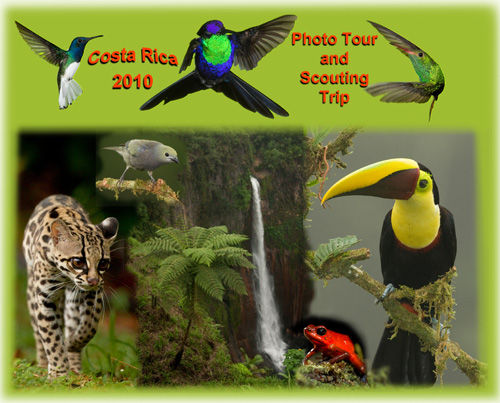
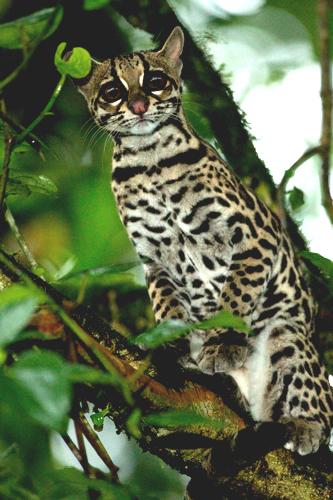
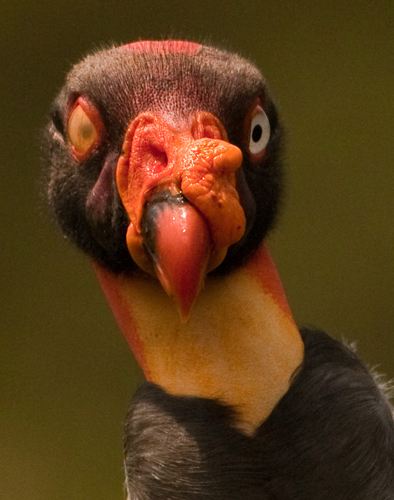
A diversity of wildlife marked our Costa Rica Photo Tour and our Scouting Trip, providing a wonderful representation of this biologically rich area. We covered several locations, including a great lodge we'll incorporate into next year's tour near the Nicarauga border, the coastal flatlands of Tortugero, the Arenal Volcano, and two hummingbird locations.
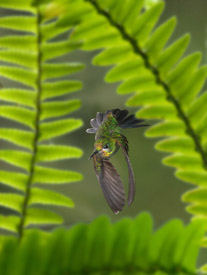
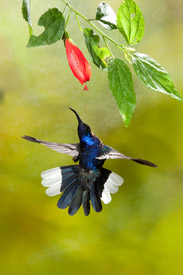
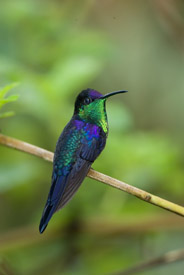
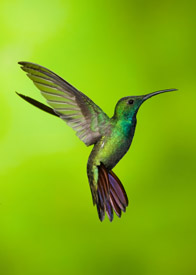
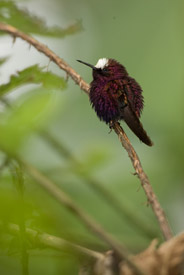
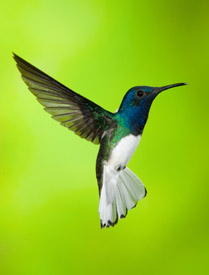
We had a variety of hummingbirds on the Photo Tour, including
green-crowned brilliant, sabrewing, violet-crowned woodnymph;
mango, snowcap, and white-necked jacobin.
The Scouting Trip
Our first destination was a little known lodge in northern Costa Rica, not far from the Nicarauga border. We had three target species, and one of these, the spectacular King Vulture, was a bird I'd hoped to see for years. The other two species, the keel-billed and chestnut mandible toucans, were very easy to shoot, done from the porch of our lodge at a distance of about 35 feet!
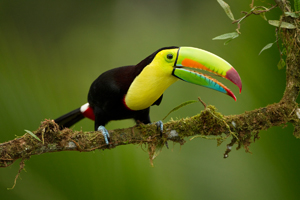

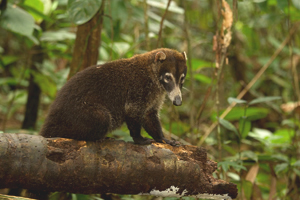 Additionally, we photographed a variety of birds from the porch, including brown-hooded parrots, two species of parakeets, five different and very colorful tanagers, woodpeckers, crow-sized and gaudy Montezuma's oropendelas, and other birds. A great network of trails leads into the jungle where we photographed pug-nosed anoles, leaf-cutter ants, two different species of poison-arrow frogs, and a large troop of white-faced coatimundis, a raccoon-like relative that are tame here but which have eluded me in other locations. We enjoyed this area so much, and felt that the shooting was so productive, that we will incorporate a three night visit to this area on our 2011 photo tour.
Additionally, we photographed a variety of birds from the porch, including brown-hooded parrots, two species of parakeets, five different and very colorful tanagers, woodpeckers, crow-sized and gaudy Montezuma's oropendelas, and other birds. A great network of trails leads into the jungle where we photographed pug-nosed anoles, leaf-cutter ants, two different species of poison-arrow frogs, and a large troop of white-faced coatimundis, a raccoon-like relative that are tame here but which have eluded me in other locations. We enjoyed this area so much, and felt that the shooting was so productive, that we will incorporate a three night visit to this area on our 2011 photo tour.
 En route to our next destination we stopped at a small ranch where the owner, a real animal lover, reminded Mary and I of ourselves where, if we lived here, we'd have a ranch very much like his. The owner had a collection of scarlet and great green macaws which he's raised and released back into the wild, in their historic range, and the macaws fly freely around the trees. He also has a large enclosure where he has a Baird's tapir, which along with the similar-looking Brazilian tapir is the largest native land mammal in Central and South America. Tapirs are members of the order Perissodactyla, the same order that horses, zebras, and rhinocerouses belong to, and the tapir, as a large, tasty mammal, is very rarely seen. I've only seen one Baird's tapir in the wild, at night, in Barrow Colorado, Panama.
En route to our next destination we stopped at a small ranch where the owner, a real animal lover, reminded Mary and I of ourselves where, if we lived here, we'd have a ranch very much like his. The owner had a collection of scarlet and great green macaws which he's raised and released back into the wild, in their historic range, and the macaws fly freely around the trees. He also has a large enclosure where he has a Baird's tapir, which along with the similar-looking Brazilian tapir is the largest native land mammal in Central and South America. Tapirs are members of the order Perissodactyla, the same order that horses, zebras, and rhinocerouses belong to, and the tapir, as a large, tasty mammal, is very rarely seen. I've only seen one Baird's tapir in the wild, at night, in Barrow Colorado, Panama.
 The rancher also has two jaguars that we photographed by placing our lenses right against the fence. While I did so, one of the jaguars, a 'friendly' female, came close and I had the thrill of cautiously scratching it around the eyes and behind its ears. At one point, when I wasn't watching, the jaguar stuck a paw through the fence and hooked my LensCoat tripod leg cover with a sharp claw. I tried freeing its claw without getting myself hooked, but in the end the jaguar tore a slice in the cover as it pulled its leg back into the cage. We discussed with the owner how interesting it could be to make his enclosure larger (it was already a very nice size) and landscaped for photography. While photographing a captive jaguar will never compare to the thrill we experience photographing wild jaguars in the Pantanal, having the opportunity to shoot this much smaller variety (about 2/3rds the size of the Pantanal jaguars) on a photo tour would still be rewarding. We plan on stopping there as we continue on our 2011 Photo Tour, next year.
The rancher also has two jaguars that we photographed by placing our lenses right against the fence. While I did so, one of the jaguars, a 'friendly' female, came close and I had the thrill of cautiously scratching it around the eyes and behind its ears. At one point, when I wasn't watching, the jaguar stuck a paw through the fence and hooked my LensCoat tripod leg cover with a sharp claw. I tried freeing its claw without getting myself hooked, but in the end the jaguar tore a slice in the cover as it pulled its leg back into the cage. We discussed with the owner how interesting it could be to make his enclosure larger (it was already a very nice size) and landscaped for photography. While photographing a captive jaguar will never compare to the thrill we experience photographing wild jaguars in the Pantanal, having the opportunity to shoot this much smaller variety (about 2/3rds the size of the Pantanal jaguars) on a photo tour would still be rewarding. We plan on stopping there as we continue on our 2011 Photo Tour, next year.

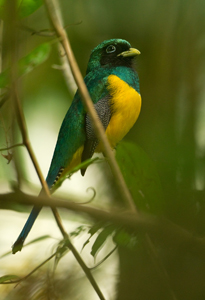
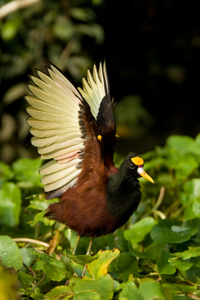
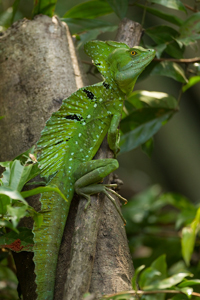
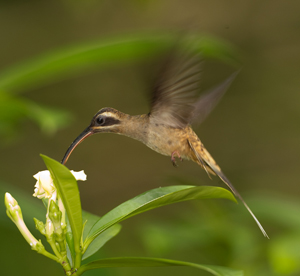
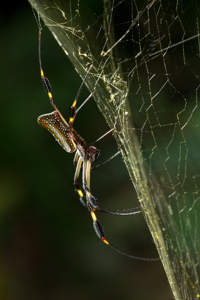
A raccoon foraging along the canal, a violaceous trogon, northern jacana,
seond row: plumed basilisk, long-billed hermit hummingbird, argiope spider.
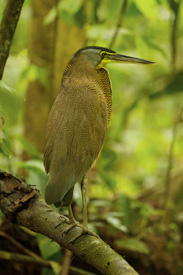 Our next stop was one I'd hoped to visit for years, Tortuguero National Park along the Atlantic coast. Here vast armadas of Kemp's sea turtles gather by the thousands each year to nest, in what is probably the largest and most dramatic collection of sea turtles coming ashore anywhere in the world. Unfortunately, March isn't the time for turtles, but the habitat, where tropical birds, reptiles, and mammals are common, was still worth visiting. The lodge we used was one of the smallest in the area, but still I was astounded by the number of tourists and the touristy-air that the lodge had. Tortuguero, we were told, is popular among European tourists as a sort of resort. The shooting on the lodge grounds, nonetheless, was good, and we filmed four different hummingbirds, the dinosaur-like Plumed Basilisk lizard, and some great birds here. The true 'game-viewing' is done by boats, and that shooting was excellent, where we saw and shot our first Greater Potoo, a nighthawk-like bird that sits on an open tree limb, head pointed skyward (at least when people are about) and looking like a broken-off limb. Bare-throated tiger herons, various egrets, and the most tolerant Jacanas I've ever seen were highlights. It was hot here, and logistically a bit difficult for a group, and we opted to exclude this area for our next Costa Rica trip. However, in retrospect, I found that I grew fonder of the area than I felt while there, and I suspect we'll return here on a tour some day.
Our next stop was one I'd hoped to visit for years, Tortuguero National Park along the Atlantic coast. Here vast armadas of Kemp's sea turtles gather by the thousands each year to nest, in what is probably the largest and most dramatic collection of sea turtles coming ashore anywhere in the world. Unfortunately, March isn't the time for turtles, but the habitat, where tropical birds, reptiles, and mammals are common, was still worth visiting. The lodge we used was one of the smallest in the area, but still I was astounded by the number of tourists and the touristy-air that the lodge had. Tortuguero, we were told, is popular among European tourists as a sort of resort. The shooting on the lodge grounds, nonetheless, was good, and we filmed four different hummingbirds, the dinosaur-like Plumed Basilisk lizard, and some great birds here. The true 'game-viewing' is done by boats, and that shooting was excellent, where we saw and shot our first Greater Potoo, a nighthawk-like bird that sits on an open tree limb, head pointed skyward (at least when people are about) and looking like a broken-off limb. Bare-throated tiger herons, various egrets, and the most tolerant Jacanas I've ever seen were highlights. It was hot here, and logistically a bit difficult for a group, and we opted to exclude this area for our next Costa Rica trip. However, in retrospect, I found that I grew fonder of the area than I felt while there, and I suspect we'll return here on a tour some day.
Our last location was repeated on our tour, so I'll pass on a description here. We returned to San Jose and to the Bouganvilla Hotel where we had a two day break before our tour formally began. This gave us time to edit nearly 80 gigs of shooting, and perhaps more importantly, to have laundry redone! Mary had tried to wash out some clothes on the trip but at both Tortugero and our last stop it was so damp that they never dried, and, when we tried drying the clothes by simply wearing them, they smelled so moldy that we felt we were wearing old sneakers! The lesson -- have the hotels do the laundry!
The Photo Tour
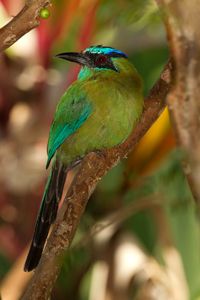 Almost everyone arrived a day before the tour, which provided time to enjoy the orchid-filled grounds of our hotel. The torquoise-colored blue-crowned mot-mot lives on the grounds, and this large, jay-like bird sits quietly in shrubs waiting for insects and small frogs and lizards. The bird is easy to miss as it sits inconspicuously waiting for prey but we had luck, and found several, including one that a few of us worked for over an hour at frame-filling, minimum focus distances.
Almost everyone arrived a day before the tour, which provided time to enjoy the orchid-filled grounds of our hotel. The torquoise-colored blue-crowned mot-mot lives on the grounds, and this large, jay-like bird sits quietly in shrubs waiting for insects and small frogs and lizards. The bird is easy to miss as it sits inconspicuously waiting for prey but we had luck, and found several, including one that a few of us worked for over an hour at frame-filling, minimum focus distances.
We left the hotel the following day, heading to the Arenal Volcano, Costa Rica's most active and accessible volcano. En route we stopped at a small nature reserve with a great bird feeder where chestnut-collared aracaris, various tanagers, thrushes, and woodpeckers fed close by. The reserve is best known for a small colony of the oddly shaped boat-billed heron, a black-crowned night heron look-alike but with a huge bill. This heron colony surrounds a small lake, or a large pond, and several birds, including a few on nests, were close by and easily filmed.
It rained while we photographed, and near one of the shelters where we waited out a more intense rain we discovered a couple of common tent-making bats roosting beneath a large leaf. These unusual bats roost beneath leaves, and some species actually cut the leaf stem to creat a distinctive hut-like shelter. With the humidity and heat my glasses steamed up, and in the low light focusing was difficult, so I headed back to our tour bus to borrow a flashlight from one of our guides. With better light, and adding a 25mm extension tube to my 500mm, I finally got some nice shots.
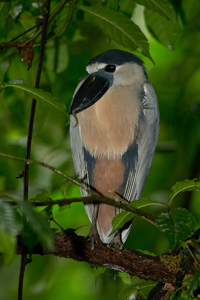
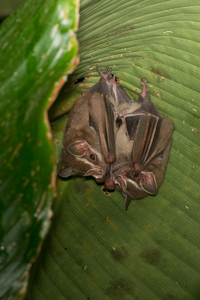
It continued to rain as we drove on to Arenal. 2010 was an El Nino year, and the US had experienced heavy rains and unusually severe snow storms. In Costa Rica, the El Nino manifested itself with unusually prolonged rains during the height of the dry season. We hoped that the rain would stop during the night and, by dawn, the skies would be clear and the volcano visible in the dim twightlight hours, and that hope was intensified while we had dinner at our lodge when Arenal erupted several times, creating ominous rumbles and blasts. We're accustomed to the earth being silent, so its a bit unsettling, and very exciting, to be near a 'living' earth, panting, gasping, and rasping periodically. Some of the rumbles sounded like a canvas sheet being slapped by a rug-beater, and others sounded like explosive blasts. Once, during dinner, we rushed to the balcony to watch a stream of glowing lava that too quickly disappeared in the gloom of the mist and fog. And during the night, as Mary and I woke up constantly to check for clearing skies, we witnessed a spectacular eruption where the sky brightened with arching loops of lava and the cone brightened with streams of molten rock, but before we could even consider waking our tour participants the heat and glow dissipated, and the magic of the mountain merged once more into the inky blackness of the wet jungle night.
The following day we visited the best Reptile and Amphibian Zoo I've ever seen outside the US, where we photographed, outside the cages, a variety of different species. The owner has a vast collection of native herptiles (reptiles and amphibians) and he was extremely helpful and sharing, as we photographed lizards, frogs and treefrogs and toads and dart frogs, and snakes with our electronic flash studio setup.
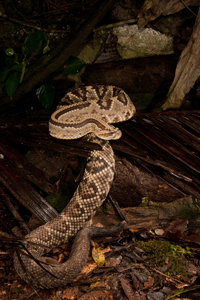
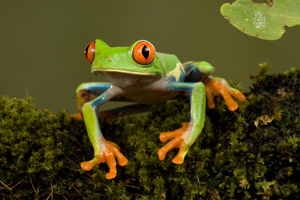
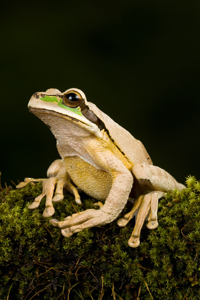
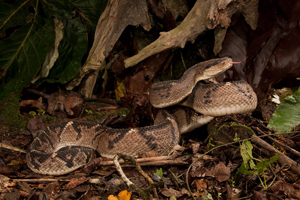

Cascabel or neotropical rattlesnake, red-eye treefrog, rainforest frog,
second row: bushmaster, fer-de-lance.
I was particularly keen on photographing two species of snakes I've lusted to see in the wild, the much feared Fer-de-Lance and the largest pit viper, and second largest venomous snake in the world, the Bushmaster. I made a jungle floor set and the zoo owner brought out the snakes, and the shooting -- of those two, and also a jumping viper, and a cascabel or tropical rattlesnake, was superb. The photography was so good that our day simply flew by, so next year we're adding an extra day at Arenal so that we'll have a three night chance at seeing and photographing the volcano, and we'll have two afternoons where we'll photograph various species, covering many more species than a single day's visit allows. It was great!
 It rained throughout the day and through the night, so much so that it seemed like the volcano had been extinguished by the deluge for it was quiet throughout dinner and the night. We awoke early, hoping to see one of the rarest of Central America's cats, the tiger cat or oncilla, a small spotted cat that resembles an ocelot or little leopard. An orphan oncilla cub had been raised and released near Arenal, and the cat periodically appears to visit its former care-giver. He didn't give us much hope as the oncilla usually stays within the forest when it rains, and it was doing raining. Still, we had our hopes up, as the cat had a half-grown cub that lacked the boldness and fearlessness of its mother, and we hoped to get a glimpse of either one.
It rained throughout the day and through the night, so much so that it seemed like the volcano had been extinguished by the deluge for it was quiet throughout dinner and the night. We awoke early, hoping to see one of the rarest of Central America's cats, the tiger cat or oncilla, a small spotted cat that resembles an ocelot or little leopard. An orphan oncilla cub had been raised and released near Arenal, and the cat periodically appears to visit its former care-giver. He didn't give us much hope as the oncilla usually stays within the forest when it rains, and it was doing raining. Still, we had our hopes up, as the cat had a half-grown cub that lacked the boldness and fearlessness of its mother, and we hoped to get a glimpse of either one.
Within minutes of arriving at the site the oncilla appeared and trotted straight at us, eventually running right through our legs as it looked for a chicken-bit handout. After the cat fed it returned to the forest edge where the oncilla climbed several trees, and paused long enough for some great shooting. After a few minutes the cat disappeared and we thought the show was over, but as we began to leave she reappeared and, remarkably, so did her cub, which showed up along the forest edge and watched us for a long half-minute before disappearing. It was a magical moment.
 We headed to our next destination where we'd begin to the second major leg of our tour, photographing hummingbirds. En route we stopped at an unusual roadside opportunity where about 50 tree iguanas lounge at eye-level on the tops of trees along the road. Normally one sees iguanas high overhead, or on branches over a stream where they're likely to drop like missles when disturbed, so having the chance to shoot iguanas close and unconcerned was special.
We headed to our next destination where we'd begin to the second major leg of our tour, photographing hummingbirds. En route we stopped at an unusual roadside opportunity where about 50 tree iguanas lounge at eye-level on the tops of trees along the road. Normally one sees iguanas high overhead, or on branches over a stream where they're likely to drop like missles when disturbed, so having the chance to shoot iguanas close and unconcerned was special.
We stopped at another stop as well, where we hoped to film a beautiful mountain catarack but the fog and rain made the gorge an empty chasm of gray. On our scouting trip we'd spent two nights here where we photographed hummers at our setups, and here on the tour we spent the entire afternoon shooting hummers that visited a flower we baited with sugar water. The shooting was fun, and a great exercise in balancing flash and natural light, and here, just as we started shooting, I stupidly didn't check if my 500mm was securely mounted on my Wimberley gimbal head and I had the lens, and my BRAND NEW MARK IV camera fall to the cement floor. The lens wasn't damaged -- I think I kicked at the lens as it fell, breaking the fall, but the impact flattened the camera mount's locking pin. The camera was otherwise not damaged, and I could still use my 500mm, but I had to be very careful (duh, too late!) whenever I used the Mark IV so that the camera wasn't turned so that it could fall off the lens. Throughout the rest of the trip I used the camera, but I had to be very, very careful!
Our next destination ended up to be my favorite. Located in the lower reaches of forest clad mountains, the area hosts a small population of resplendent quetzals, one of the most beautiful birds in the world, several hummingbird species, and a great area for shooting natural-light songbirds and guans. The forest on the grounds was beautiful, and several trails paralled a picturesque jungle stream.
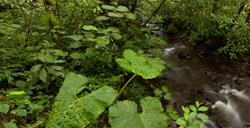
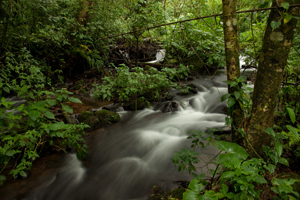
It was raining, and our Costa Rican guide had never experienced rain here during a tour, so we had to improvise. We ended up shooting beneath a high roofed-in area that the hummingbirds quickly accepted, and had the added bonus of eliminating the worry of ghost-imaging from bright natural light. The area was so good that we'll use the same location on next year's tour.
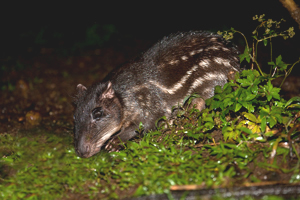
Pacca, a deer-like rodent about the size of a beagle,
feeding near the bird feeder at night.
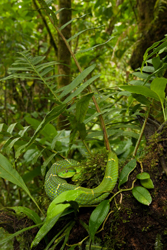 For Mary and I the lodge here was our favorite, with a genial host and with numerous shooting opportunities, including the only spot I've seen where one can photograph agoutis and paccas (almost deer-like big rodents) that fed around the bird feeders. One of the true highlights of this visit, and indeed of the entire trip, was when our driver-guide found a striped palm viper along a trail. The snake had recently eaten and was still, and our entire group hiked the short distance to photograph it as it lay unperturbed on its photogenic perch.
For Mary and I the lodge here was our favorite, with a genial host and with numerous shooting opportunities, including the only spot I've seen where one can photograph agoutis and paccas (almost deer-like big rodents) that fed around the bird feeders. One of the true highlights of this visit, and indeed of the entire trip, was when our driver-guide found a striped palm viper along a trail. The snake had recently eaten and was still, and our entire group hiked the short distance to photograph it as it lay unperturbed on its photogenic perch.
The hummingbird shooting was great, and the shooting never ceased at our three setups where we did different arrangements at each, with one for perching, another for free flight, and a third for adding a prop. In the hedgerow nearby even more hummers, and one or two more species, fed and perched, and for those who availed themselves of the opportunity, there was even more shooting. We liked this lodge so much that next year we're adding an extra day to stay for three full days so that we can maximize all of the opportunities, of shooting landscapes, paccas and agoutis, birds at the feeder, and the hummingbirds, and perhaps, if we're lucky, even a quetzal!
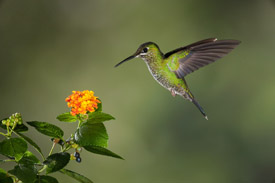
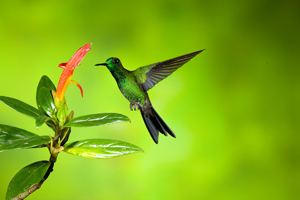
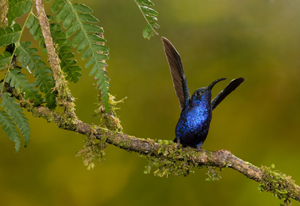
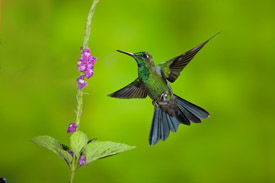
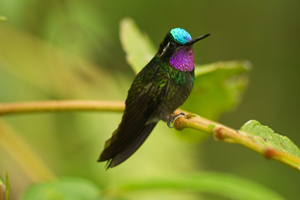
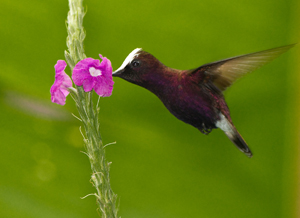
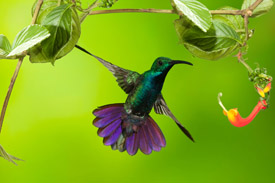
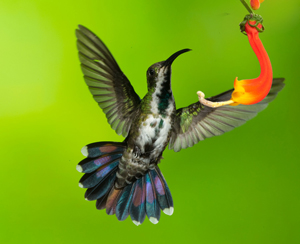
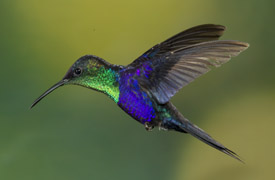
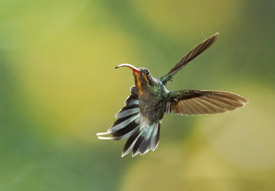
Top row: green-crowned brilliant; Second row: sabrewing, g-c brilliant;
Third row: purple-throated mountain gem, snowcap;
Fourth row: male and female mango;
Bottom row: violet-crowned woodnymph, green hermit
For our last location we drove south through San Jose, stopping en route for lunch and arriving in the early afternoon. We had expected some natural light setups to have been erected, and a hummingbird setup and shelter built in the forest, but neither was even started. It wasn't long before we had our natural light perch situation addressed, and the following morning we had a beautiful perching area. The forest setup, as it turned out, wasn't needed, as one male hummingbird had taken over the location and was preventing any other bird from visiting the feeder.
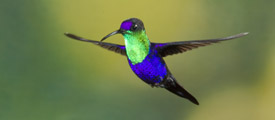 Instead, we did three setups right around the lodge, and here we had about six different species, including hermit, jacobin, wood nymph, mango, and emerald hummingbirds, and along the flowery hedgerow, the usually elusive and highly sought snowcap hummingbird. Shooting here was a challenge, for several birds claimed feeding areas forcing one of our three sets to be moved three times to avoid the dominant bird, and one of our other sets to be moved twice. Our one 'free' set was beset by bees, both honeybees and a stingless, but annoyingly sticky stingless bees, and we had to move that set twice as well!
Instead, we did three setups right around the lodge, and here we had about six different species, including hermit, jacobin, wood nymph, mango, and emerald hummingbirds, and along the flowery hedgerow, the usually elusive and highly sought snowcap hummingbird. Shooting here was a challenge, for several birds claimed feeding areas forcing one of our three sets to be moved three times to avoid the dominant bird, and one of our other sets to be moved twice. Our one 'free' set was beset by bees, both honeybees and a stingless, but annoyingly sticky stingless bees, and we had to move that set twice as well!
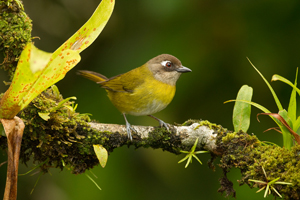
While the shooting here was productive, it had the potential to be disasterous, as the bees were definitely a problem and the aggressive and dominant hummingbirds (two different species caused problems) could literally close down a set. We did have a productive night walk for macro subjects, but our first location had that potential as well, as did our other hummingbird location, so Mary and I do not feel that elminating this from our 2011 tour would hurt the tour. Accordingly, we probably won't be back unless we add this location as a special extension devoted solely for hummingbirds.
That said, the lodge had what most participants felt was the best food, and our shooting was good. But, considering the travel time required, the bees, and the 'bad' birds, we feel that our time will be better spent elsewhere.
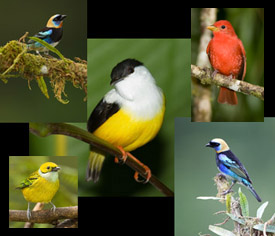 A collage of some of our birds - a golden-hooded, summer, golden-hooded, and silver-throated tanagers, and center, white-collared manakin.
A collage of some of our birds - a golden-hooded, summer, golden-hooded, and silver-throated tanagers, and center, white-collared manakin.
I, apparently, don't do very well at lodges. In Rwanda two years ago I followed the manager of a lodge up a stairs, crashing my head into a low overhang a millisecond before he turned to say, 'watch out for the overhang!' That sent me down the steps and nearly broke my neck. On this trip, a throw rug on a polished wood floor at the top of the steps leading to our room fired out from underfoot when I stepped on it, and although I crashed to the floor I fell in, and not down, the steep steps. The angle that I was moving luckily kept me from zipping down the steps on my back, saving me from some very unlucky breaks, I'm sure.
You may have noticed that I did not name the lodges or locations that we visited, and I did so purposely as our tour operator has spent quite a bit of time researching new locations and cultivating relationships with the owners of the lodges . Also, since one of our spots was a bit challenging for us, it might discourage other photographers from visiting here, and that would be a disservice to the lodge, since you may not have the challenges we had and instead might simply have the best experience ever. Mary and I apologize for this omission of locations, but I do not believe it detracts from the essense of this report.
 This tour was very equipment intensive. Mary and I carried 10 electronic flashes that fired wireless for triggering our two hummingbird sets, and our guide had another set of four for our third set. We used 12 Bogen light stands, and we packed along 6 Bogen articulating arms, 8 Bogen Super Clamps, and 4 Bogen large clamps for securing props. From Wimberley we used 8 Plamps, securing ferns or flowers, and well over a dozen small hardware clamps for securing the canvan print backgrounds my friend Rick Holt printed for us before the trip.
This tour was very equipment intensive. Mary and I carried 10 electronic flashes that fired wireless for triggering our two hummingbird sets, and our guide had another set of four for our third set. We used 12 Bogen light stands, and we packed along 6 Bogen articulating arms, 8 Bogen Super Clamps, and 4 Bogen large clamps for securing props. From Wimberley we used 8 Plamps, securing ferns or flowers, and well over a dozen small hardware clamps for securing the canvan print backgrounds my friend Rick Holt printed for us before the trip.
Both Mary and I had, in our basic kit, a 500mm, 180mm macro, 28-300mm, and 16-35mm zoom lens, 12mm and 25mm extension tubes, and we also brought along as backup a 70-200 f4, a 400mm f5.6 lens, a 1.4X and 2X tele-converter, and a 100mm macro lens. Each of us had a 580 flash and a tele-flash attachment for our fill-in flash work, and I carried along a twin-light macro flash system for macro work, and Gitzo carbon-fiber tripods for supports, mounted with the Wimberley II Gimbal heads. We carried our field equipment in our Kiboko backpacks, which we've been using for a half year and our loving more each time we use them. Because of the contant rains we protected our long lenses with long lens rain covers made by FotoSharp.
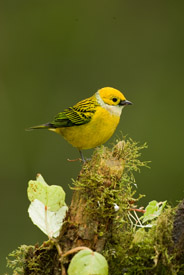
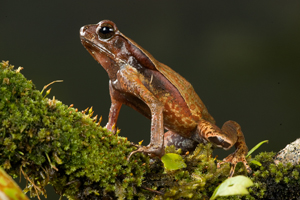
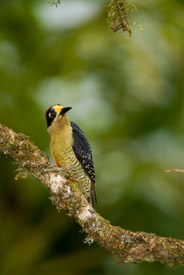
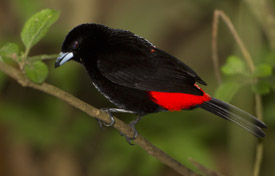
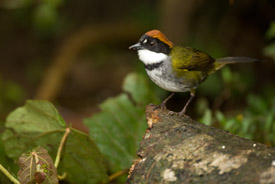

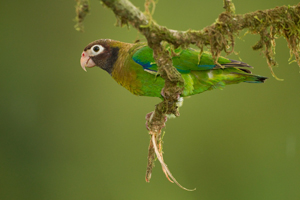
Top row: silver-throated tanager, toad, black-cheeked woodpecker;
Middle: Passerini tanager, chestnut-capped brush-finch;
Bottom row: chestnut-headed oropendola, brown-hooded parrot
We carried our 4 camera bodies, 500mm lenses, and almost all of our other lenses in our two carry-on cases, 19" long, that easily fit into the plane's overhead compartment.
Next year, we plan on doing our Costa Rica trip in mid-June. We'll have the brochure up soon, but the details are this: 3 nights at the lodge in northern Nicaragua, for toucans and other birds, poison dart frogs and jungle wildlife; 3 nights at Arenal volcano, for the volcano, the birds and scenics around the lodge, and two opportunities for reptiles and amphibian shooting at the reptile zoo, and 4 nights at our hummingbird location for 3 full days of hummingbird and other bird photography, jungle landscapes, and nocturnal mammals. We only take 6 people, so everyone will have plenty of time at our high-speed hummingbird sets.
We anticipate this trip will fill quickly, so if you are interested, contact our office to be placed on our 'first alert list.'
Contact us by e-mail: info@hoothollow.com
Call us at (717) 543-6423 Or FAX us at: (717) 543-5342.
Return to HomePage
Costa Rica 2010
Scouting Trip and
Photo Tour



A diversity of wildlife marked our Costa Rica Photo Tour and our Scouting Trip, providing a wonderful representation of this biologically rich area. We covered several locations, including a great lodge we'll incorporate into next year's tour near the Nicarauga border, the coastal flatlands of Tortugero, the Arenal Volcano, and two hummingbird locations.






We had a variety of hummingbirds on the Photo Tour, including
green-crowned brilliant, sabrewing, violet-crowned woodnymph;
mango, snowcap, and white-necked jacobin.
The Scouting Trip
Our first destination was a little known lodge in northern Costa Rica, not far from the Nicarauga border. We had three target species, and one of these, the spectacular King Vulture, was a bird I'd hoped to see for years. The other two species, the keel-billed and chestnut mandible toucans, were very easy to shoot, done from the porch of our lodge at a distance of about 35 feet!


 Additionally, we photographed a variety of birds from the porch, including brown-hooded parrots, two species of parakeets, five different and very colorful tanagers, woodpeckers, crow-sized and gaudy Montezuma's oropendelas, and other birds. A great network of trails leads into the jungle where we photographed pug-nosed anoles, leaf-cutter ants, two different species of poison-arrow frogs, and a large troop of white-faced coatimundis, a raccoon-like relative that are tame here but which have eluded me in other locations. We enjoyed this area so much, and felt that the shooting was so productive, that we will incorporate a three night visit to this area on our 2011 photo tour.
Additionally, we photographed a variety of birds from the porch, including brown-hooded parrots, two species of parakeets, five different and very colorful tanagers, woodpeckers, crow-sized and gaudy Montezuma's oropendelas, and other birds. A great network of trails leads into the jungle where we photographed pug-nosed anoles, leaf-cutter ants, two different species of poison-arrow frogs, and a large troop of white-faced coatimundis, a raccoon-like relative that are tame here but which have eluded me in other locations. We enjoyed this area so much, and felt that the shooting was so productive, that we will incorporate a three night visit to this area on our 2011 photo tour.
 En route to our next destination we stopped at a small ranch where the owner, a real animal lover, reminded Mary and I of ourselves where, if we lived here, we'd have a ranch very much like his. The owner had a collection of scarlet and great green macaws which he's raised and released back into the wild, in their historic range, and the macaws fly freely around the trees. He also has a large enclosure where he has a Baird's tapir, which along with the similar-looking Brazilian tapir is the largest native land mammal in Central and South America. Tapirs are members of the order Perissodactyla, the same order that horses, zebras, and rhinocerouses belong to, and the tapir, as a large, tasty mammal, is very rarely seen. I've only seen one Baird's tapir in the wild, at night, in Barrow Colorado, Panama.
En route to our next destination we stopped at a small ranch where the owner, a real animal lover, reminded Mary and I of ourselves where, if we lived here, we'd have a ranch very much like his. The owner had a collection of scarlet and great green macaws which he's raised and released back into the wild, in their historic range, and the macaws fly freely around the trees. He also has a large enclosure where he has a Baird's tapir, which along with the similar-looking Brazilian tapir is the largest native land mammal in Central and South America. Tapirs are members of the order Perissodactyla, the same order that horses, zebras, and rhinocerouses belong to, and the tapir, as a large, tasty mammal, is very rarely seen. I've only seen one Baird's tapir in the wild, at night, in Barrow Colorado, Panama.
 The rancher also has two jaguars that we photographed by placing our lenses right against the fence. While I did so, one of the jaguars, a 'friendly' female, came close and I had the thrill of cautiously scratching it around the eyes and behind its ears. At one point, when I wasn't watching, the jaguar stuck a paw through the fence and hooked my LensCoat tripod leg cover with a sharp claw. I tried freeing its claw without getting myself hooked, but in the end the jaguar tore a slice in the cover as it pulled its leg back into the cage. We discussed with the owner how interesting it could be to make his enclosure larger (it was already a very nice size) and landscaped for photography. While photographing a captive jaguar will never compare to the thrill we experience photographing wild jaguars in the Pantanal, having the opportunity to shoot this much smaller variety (about 2/3rds the size of the Pantanal jaguars) on a photo tour would still be rewarding. We plan on stopping there as we continue on our 2011 Photo Tour, next year.
The rancher also has two jaguars that we photographed by placing our lenses right against the fence. While I did so, one of the jaguars, a 'friendly' female, came close and I had the thrill of cautiously scratching it around the eyes and behind its ears. At one point, when I wasn't watching, the jaguar stuck a paw through the fence and hooked my LensCoat tripod leg cover with a sharp claw. I tried freeing its claw without getting myself hooked, but in the end the jaguar tore a slice in the cover as it pulled its leg back into the cage. We discussed with the owner how interesting it could be to make his enclosure larger (it was already a very nice size) and landscaped for photography. While photographing a captive jaguar will never compare to the thrill we experience photographing wild jaguars in the Pantanal, having the opportunity to shoot this much smaller variety (about 2/3rds the size of the Pantanal jaguars) on a photo tour would still be rewarding. We plan on stopping there as we continue on our 2011 Photo Tour, next year.






A raccoon foraging along the canal, a violaceous trogon, northern jacana,
seond row: plumed basilisk, long-billed hermit hummingbird, argiope spider.
 Our next stop was one I'd hoped to visit for years, Tortuguero National Park along the Atlantic coast. Here vast armadas of Kemp's sea turtles gather by the thousands each year to nest, in what is probably the largest and most dramatic collection of sea turtles coming ashore anywhere in the world. Unfortunately, March isn't the time for turtles, but the habitat, where tropical birds, reptiles, and mammals are common, was still worth visiting. The lodge we used was one of the smallest in the area, but still I was astounded by the number of tourists and the touristy-air that the lodge had. Tortuguero, we were told, is popular among European tourists as a sort of resort. The shooting on the lodge grounds, nonetheless, was good, and we filmed four different hummingbirds, the dinosaur-like Plumed Basilisk lizard, and some great birds here. The true 'game-viewing' is done by boats, and that shooting was excellent, where we saw and shot our first Greater Potoo, a nighthawk-like bird that sits on an open tree limb, head pointed skyward (at least when people are about) and looking like a broken-off limb. Bare-throated tiger herons, various egrets, and the most tolerant Jacanas I've ever seen were highlights. It was hot here, and logistically a bit difficult for a group, and we opted to exclude this area for our next Costa Rica trip. However, in retrospect, I found that I grew fonder of the area than I felt while there, and I suspect we'll return here on a tour some day.
Our next stop was one I'd hoped to visit for years, Tortuguero National Park along the Atlantic coast. Here vast armadas of Kemp's sea turtles gather by the thousands each year to nest, in what is probably the largest and most dramatic collection of sea turtles coming ashore anywhere in the world. Unfortunately, March isn't the time for turtles, but the habitat, where tropical birds, reptiles, and mammals are common, was still worth visiting. The lodge we used was one of the smallest in the area, but still I was astounded by the number of tourists and the touristy-air that the lodge had. Tortuguero, we were told, is popular among European tourists as a sort of resort. The shooting on the lodge grounds, nonetheless, was good, and we filmed four different hummingbirds, the dinosaur-like Plumed Basilisk lizard, and some great birds here. The true 'game-viewing' is done by boats, and that shooting was excellent, where we saw and shot our first Greater Potoo, a nighthawk-like bird that sits on an open tree limb, head pointed skyward (at least when people are about) and looking like a broken-off limb. Bare-throated tiger herons, various egrets, and the most tolerant Jacanas I've ever seen were highlights. It was hot here, and logistically a bit difficult for a group, and we opted to exclude this area for our next Costa Rica trip. However, in retrospect, I found that I grew fonder of the area than I felt while there, and I suspect we'll return here on a tour some day.
Our last location was repeated on our tour, so I'll pass on a description here. We returned to San Jose and to the Bouganvilla Hotel where we had a two day break before our tour formally began. This gave us time to edit nearly 80 gigs of shooting, and perhaps more importantly, to have laundry redone! Mary had tried to wash out some clothes on the trip but at both Tortugero and our last stop it was so damp that they never dried, and, when we tried drying the clothes by simply wearing them, they smelled so moldy that we felt we were wearing old sneakers! The lesson -- have the hotels do the laundry!
The Photo Tour
 Almost everyone arrived a day before the tour, which provided time to enjoy the orchid-filled grounds of our hotel. The torquoise-colored blue-crowned mot-mot lives on the grounds, and this large, jay-like bird sits quietly in shrubs waiting for insects and small frogs and lizards. The bird is easy to miss as it sits inconspicuously waiting for prey but we had luck, and found several, including one that a few of us worked for over an hour at frame-filling, minimum focus distances.
Almost everyone arrived a day before the tour, which provided time to enjoy the orchid-filled grounds of our hotel. The torquoise-colored blue-crowned mot-mot lives on the grounds, and this large, jay-like bird sits quietly in shrubs waiting for insects and small frogs and lizards. The bird is easy to miss as it sits inconspicuously waiting for prey but we had luck, and found several, including one that a few of us worked for over an hour at frame-filling, minimum focus distances.
We left the hotel the following day, heading to the Arenal Volcano, Costa Rica's most active and accessible volcano. En route we stopped at a small nature reserve with a great bird feeder where chestnut-collared aracaris, various tanagers, thrushes, and woodpeckers fed close by. The reserve is best known for a small colony of the oddly shaped boat-billed heron, a black-crowned night heron look-alike but with a huge bill. This heron colony surrounds a small lake, or a large pond, and several birds, including a few on nests, were close by and easily filmed.
It rained while we photographed, and near one of the shelters where we waited out a more intense rain we discovered a couple of common tent-making bats roosting beneath a large leaf. These unusual bats roost beneath leaves, and some species actually cut the leaf stem to creat a distinctive hut-like shelter. With the humidity and heat my glasses steamed up, and in the low light focusing was difficult, so I headed back to our tour bus to borrow a flashlight from one of our guides. With better light, and adding a 25mm extension tube to my 500mm, I finally got some nice shots.


It continued to rain as we drove on to Arenal. 2010 was an El Nino year, and the US had experienced heavy rains and unusually severe snow storms. In Costa Rica, the El Nino manifested itself with unusually prolonged rains during the height of the dry season. We hoped that the rain would stop during the night and, by dawn, the skies would be clear and the volcano visible in the dim twightlight hours, and that hope was intensified while we had dinner at our lodge when Arenal erupted several times, creating ominous rumbles and blasts. We're accustomed to the earth being silent, so its a bit unsettling, and very exciting, to be near a 'living' earth, panting, gasping, and rasping periodically. Some of the rumbles sounded like a canvas sheet being slapped by a rug-beater, and others sounded like explosive blasts. Once, during dinner, we rushed to the balcony to watch a stream of glowing lava that too quickly disappeared in the gloom of the mist and fog. And during the night, as Mary and I woke up constantly to check for clearing skies, we witnessed a spectacular eruption where the sky brightened with arching loops of lava and the cone brightened with streams of molten rock, but before we could even consider waking our tour participants the heat and glow dissipated, and the magic of the mountain merged once more into the inky blackness of the wet jungle night.
The following day we visited the best Reptile and Amphibian Zoo I've ever seen outside the US, where we photographed, outside the cages, a variety of different species. The owner has a vast collection of native herptiles (reptiles and amphibians) and he was extremely helpful and sharing, as we photographed lizards, frogs and treefrogs and toads and dart frogs, and snakes with our electronic flash studio setup.





Cascabel or neotropical rattlesnake, red-eye treefrog, rainforest frog,
second row: bushmaster, fer-de-lance.
I was particularly keen on photographing two species of snakes I've lusted to see in the wild, the much feared Fer-de-Lance and the largest pit viper, and second largest venomous snake in the world, the Bushmaster. I made a jungle floor set and the zoo owner brought out the snakes, and the shooting -- of those two, and also a jumping viper, and a cascabel or tropical rattlesnake, was superb. The photography was so good that our day simply flew by, so next year we're adding an extra day at Arenal so that we'll have a three night chance at seeing and photographing the volcano, and we'll have two afternoons where we'll photograph various species, covering many more species than a single day's visit allows. It was great!
 It rained throughout the day and through the night, so much so that it seemed like the volcano had been extinguished by the deluge for it was quiet throughout dinner and the night. We awoke early, hoping to see one of the rarest of Central America's cats, the tiger cat or oncilla, a small spotted cat that resembles an ocelot or little leopard. An orphan oncilla cub had been raised and released near Arenal, and the cat periodically appears to visit its former care-giver. He didn't give us much hope as the oncilla usually stays within the forest when it rains, and it was doing raining. Still, we had our hopes up, as the cat had a half-grown cub that lacked the boldness and fearlessness of its mother, and we hoped to get a glimpse of either one.
It rained throughout the day and through the night, so much so that it seemed like the volcano had been extinguished by the deluge for it was quiet throughout dinner and the night. We awoke early, hoping to see one of the rarest of Central America's cats, the tiger cat or oncilla, a small spotted cat that resembles an ocelot or little leopard. An orphan oncilla cub had been raised and released near Arenal, and the cat periodically appears to visit its former care-giver. He didn't give us much hope as the oncilla usually stays within the forest when it rains, and it was doing raining. Still, we had our hopes up, as the cat had a half-grown cub that lacked the boldness and fearlessness of its mother, and we hoped to get a glimpse of either one.
Within minutes of arriving at the site the oncilla appeared and trotted straight at us, eventually running right through our legs as it looked for a chicken-bit handout. After the cat fed it returned to the forest edge where the oncilla climbed several trees, and paused long enough for some great shooting. After a few minutes the cat disappeared and we thought the show was over, but as we began to leave she reappeared and, remarkably, so did her cub, which showed up along the forest edge and watched us for a long half-minute before disappearing. It was a magical moment.
 We headed to our next destination where we'd begin to the second major leg of our tour, photographing hummingbirds. En route we stopped at an unusual roadside opportunity where about 50 tree iguanas lounge at eye-level on the tops of trees along the road. Normally one sees iguanas high overhead, or on branches over a stream where they're likely to drop like missles when disturbed, so having the chance to shoot iguanas close and unconcerned was special.
We headed to our next destination where we'd begin to the second major leg of our tour, photographing hummingbirds. En route we stopped at an unusual roadside opportunity where about 50 tree iguanas lounge at eye-level on the tops of trees along the road. Normally one sees iguanas high overhead, or on branches over a stream where they're likely to drop like missles when disturbed, so having the chance to shoot iguanas close and unconcerned was special.
We stopped at another stop as well, where we hoped to film a beautiful mountain catarack but the fog and rain made the gorge an empty chasm of gray. On our scouting trip we'd spent two nights here where we photographed hummers at our setups, and here on the tour we spent the entire afternoon shooting hummers that visited a flower we baited with sugar water. The shooting was fun, and a great exercise in balancing flash and natural light, and here, just as we started shooting, I stupidly didn't check if my 500mm was securely mounted on my Wimberley gimbal head and I had the lens, and my BRAND NEW MARK IV camera fall to the cement floor. The lens wasn't damaged -- I think I kicked at the lens as it fell, breaking the fall, but the impact flattened the camera mount's locking pin. The camera was otherwise not damaged, and I could still use my 500mm, but I had to be very careful (duh, too late!) whenever I used the Mark IV so that the camera wasn't turned so that it could fall off the lens. Throughout the rest of the trip I used the camera, but I had to be very, very careful!
Our next destination ended up to be my favorite. Located in the lower reaches of forest clad mountains, the area hosts a small population of resplendent quetzals, one of the most beautiful birds in the world, several hummingbird species, and a great area for shooting natural-light songbirds and guans. The forest on the grounds was beautiful, and several trails paralled a picturesque jungle stream.


It was raining, and our Costa Rican guide had never experienced rain here during a tour, so we had to improvise. We ended up shooting beneath a high roofed-in area that the hummingbirds quickly accepted, and had the added bonus of eliminating the worry of ghost-imaging from bright natural light. The area was so good that we'll use the same location on next year's tour.

Pacca, a deer-like rodent about the size of a beagle,
feeding near the bird feeder at night.
 For Mary and I the lodge here was our favorite, with a genial host and with numerous shooting opportunities, including the only spot I've seen where one can photograph agoutis and paccas (almost deer-like big rodents) that fed around the bird feeders. One of the true highlights of this visit, and indeed of the entire trip, was when our driver-guide found a striped palm viper along a trail. The snake had recently eaten and was still, and our entire group hiked the short distance to photograph it as it lay unperturbed on its photogenic perch.
For Mary and I the lodge here was our favorite, with a genial host and with numerous shooting opportunities, including the only spot I've seen where one can photograph agoutis and paccas (almost deer-like big rodents) that fed around the bird feeders. One of the true highlights of this visit, and indeed of the entire trip, was when our driver-guide found a striped palm viper along a trail. The snake had recently eaten and was still, and our entire group hiked the short distance to photograph it as it lay unperturbed on its photogenic perch.
The hummingbird shooting was great, and the shooting never ceased at our three setups where we did different arrangements at each, with one for perching, another for free flight, and a third for adding a prop. In the hedgerow nearby even more hummers, and one or two more species, fed and perched, and for those who availed themselves of the opportunity, there was even more shooting. We liked this lodge so much that next year we're adding an extra day to stay for three full days so that we can maximize all of the opportunities, of shooting landscapes, paccas and agoutis, birds at the feeder, and the hummingbirds, and perhaps, if we're lucky, even a quetzal!










Top row: green-crowned brilliant; Second row: sabrewing, g-c brilliant;
Third row: purple-throated mountain gem, snowcap;
Fourth row: male and female mango;
Bottom row: violet-crowned woodnymph, green hermit
For our last location we drove south through San Jose, stopping en route for lunch and arriving in the early afternoon. We had expected some natural light setups to have been erected, and a hummingbird setup and shelter built in the forest, but neither was even started. It wasn't long before we had our natural light perch situation addressed, and the following morning we had a beautiful perching area. The forest setup, as it turned out, wasn't needed, as one male hummingbird had taken over the location and was preventing any other bird from visiting the feeder.
 Instead, we did three setups right around the lodge, and here we had about six different species, including hermit, jacobin, wood nymph, mango, and emerald hummingbirds, and along the flowery hedgerow, the usually elusive and highly sought snowcap hummingbird. Shooting here was a challenge, for several birds claimed feeding areas forcing one of our three sets to be moved three times to avoid the dominant bird, and one of our other sets to be moved twice. Our one 'free' set was beset by bees, both honeybees and a stingless, but annoyingly sticky stingless bees, and we had to move that set twice as well!
Instead, we did three setups right around the lodge, and here we had about six different species, including hermit, jacobin, wood nymph, mango, and emerald hummingbirds, and along the flowery hedgerow, the usually elusive and highly sought snowcap hummingbird. Shooting here was a challenge, for several birds claimed feeding areas forcing one of our three sets to be moved three times to avoid the dominant bird, and one of our other sets to be moved twice. Our one 'free' set was beset by bees, both honeybees and a stingless, but annoyingly sticky stingless bees, and we had to move that set twice as well!

While the shooting here was productive, it had the potential to be disasterous, as the bees were definitely a problem and the aggressive and dominant hummingbirds (two different species caused problems) could literally close down a set. We did have a productive night walk for macro subjects, but our first location had that potential as well, as did our other hummingbird location, so Mary and I do not feel that elminating this from our 2011 tour would hurt the tour. Accordingly, we probably won't be back unless we add this location as a special extension devoted solely for hummingbirds.
That said, the lodge had what most participants felt was the best food, and our shooting was good. But, considering the travel time required, the bees, and the 'bad' birds, we feel that our time will be better spent elsewhere.
 A collage of some of our birds - a golden-hooded, summer, golden-hooded, and silver-throated tanagers, and center, white-collared manakin.
A collage of some of our birds - a golden-hooded, summer, golden-hooded, and silver-throated tanagers, and center, white-collared manakin.
I, apparently, don't do very well at lodges. In Rwanda two years ago I followed the manager of a lodge up a stairs, crashing my head into a low overhang a millisecond before he turned to say, 'watch out for the overhang!' That sent me down the steps and nearly broke my neck. On this trip, a throw rug on a polished wood floor at the top of the steps leading to our room fired out from underfoot when I stepped on it, and although I crashed to the floor I fell in, and not down, the steep steps. The angle that I was moving luckily kept me from zipping down the steps on my back, saving me from some very unlucky breaks, I'm sure.
You may have noticed that I did not name the lodges or locations that we visited, and I did so purposely as our tour operator has spent quite a bit of time researching new locations and cultivating relationships with the owners of the lodges . Also, since one of our spots was a bit challenging for us, it might discourage other photographers from visiting here, and that would be a disservice to the lodge, since you may not have the challenges we had and instead might simply have the best experience ever. Mary and I apologize for this omission of locations, but I do not believe it detracts from the essense of this report.
 This tour was very equipment intensive. Mary and I carried 10 electronic flashes that fired wireless for triggering our two hummingbird sets, and our guide had another set of four for our third set. We used 12 Bogen light stands, and we packed along 6 Bogen articulating arms, 8 Bogen Super Clamps, and 4 Bogen large clamps for securing props. From Wimberley we used 8 Plamps, securing ferns or flowers, and well over a dozen small hardware clamps for securing the canvan print backgrounds my friend Rick Holt printed for us before the trip.
This tour was very equipment intensive. Mary and I carried 10 electronic flashes that fired wireless for triggering our two hummingbird sets, and our guide had another set of four for our third set. We used 12 Bogen light stands, and we packed along 6 Bogen articulating arms, 8 Bogen Super Clamps, and 4 Bogen large clamps for securing props. From Wimberley we used 8 Plamps, securing ferns or flowers, and well over a dozen small hardware clamps for securing the canvan print backgrounds my friend Rick Holt printed for us before the trip.
Both Mary and I had, in our basic kit, a 500mm, 180mm macro, 28-300mm, and 16-35mm zoom lens, 12mm and 25mm extension tubes, and we also brought along as backup a 70-200 f4, a 400mm f5.6 lens, a 1.4X and 2X tele-converter, and a 100mm macro lens. Each of us had a 580 flash and a tele-flash attachment for our fill-in flash work, and I carried along a twin-light macro flash system for macro work, and Gitzo carbon-fiber tripods for supports, mounted with the Wimberley II Gimbal heads. We carried our field equipment in our Kiboko backpacks, which we've been using for a half year and our loving more each time we use them. Because of the contant rains we protected our long lenses with long lens rain covers made by FotoSharp.







Top row: silver-throated tanager, toad, black-cheeked woodpecker;
Middle: Passerini tanager, chestnut-capped brush-finch;
Bottom row: chestnut-headed oropendola, brown-hooded parrot
We carried our 4 camera bodies, 500mm lenses, and almost all of our other lenses in our two carry-on cases, 19" long, that easily fit into the plane's overhead compartment.
Next year, we plan on doing our Costa Rica trip in mid-June. We'll have the brochure up soon, but the details are this: 3 nights at the lodge in northern Nicaragua, for toucans and other birds, poison dart frogs and jungle wildlife; 3 nights at Arenal volcano, for the volcano, the birds and scenics around the lodge, and two opportunities for reptiles and amphibian shooting at the reptile zoo, and 4 nights at our hummingbird location for 3 full days of hummingbird and other bird photography, jungle landscapes, and nocturnal mammals. We only take 6 people, so everyone will have plenty of time at our high-speed hummingbird sets.
We anticipate this trip will fill quickly, so if you are interested, contact our office to be placed on our 'first alert list.'
Contact us by e-mail: info@hoothollow.com
Call us at (717) 543-6423 Or FAX us at: (717) 543-5342.
Return to HomePage
Costa Rica 2010
Scouting Trip and
Photo Tour



A diversity of wildlife marked our Costa Rica Photo Tour and our Scouting Trip, providing a wonderful representation of this biologically rich area. We covered several locations, including a great lodge we'll incorporate into next year's tour near the Nicarauga border, the coastal flatlands of Tortugero, the Arenal Volcano, and two hummingbird locations.






We had a variety of hummingbirds on the Photo Tour, including
green-crowned brilliant, sabrewing, violet-crowned woodnymph;
mango, snowcap, and white-necked jacobin.
The Scouting Trip
Our first destination was a little known lodge in northern Costa Rica, not far from the Nicarauga border. We had three target species, and one of these, the spectacular King Vulture, was a bird I'd hoped to see for years. The other two species, the keel-billed and chestnut mandible toucans, were very easy to shoot, done from the porch of our lodge at a distance of about 35 feet!


 Additionally, we photographed a variety of birds from the porch, including brown-hooded parrots, two species of parakeets, five different and very colorful tanagers, woodpeckers, crow-sized and gaudy Montezuma's oropendelas, and other birds. A great network of trails leads into the jungle where we photographed pug-nosed anoles, leaf-cutter ants, two different species of poison-arrow frogs, and a large troop of white-faced coatimundis, a raccoon-like relative that are tame here but which have eluded me in other locations. We enjoyed this area so much, and felt that the shooting was so productive, that we will incorporate a three night visit to this area on our 2011 photo tour.
Additionally, we photographed a variety of birds from the porch, including brown-hooded parrots, two species of parakeets, five different and very colorful tanagers, woodpeckers, crow-sized and gaudy Montezuma's oropendelas, and other birds. A great network of trails leads into the jungle where we photographed pug-nosed anoles, leaf-cutter ants, two different species of poison-arrow frogs, and a large troop of white-faced coatimundis, a raccoon-like relative that are tame here but which have eluded me in other locations. We enjoyed this area so much, and felt that the shooting was so productive, that we will incorporate a three night visit to this area on our 2011 photo tour.
 En route to our next destination we stopped at a small ranch where the owner, a real animal lover, reminded Mary and I of ourselves where, if we lived here, we'd have a ranch very much like his. The owner had a collection of scarlet and great green macaws which he's raised and released back into the wild, in their historic range, and the macaws fly freely around the trees. He also has a large enclosure where he has a Baird's tapir, which along with the similar-looking Brazilian tapir is the largest native land mammal in Central and South America. Tapirs are members of the order Perissodactyla, the same order that horses, zebras, and rhinocerouses belong to, and the tapir, as a large, tasty mammal, is very rarely seen. I've only seen one Baird's tapir in the wild, at night, in Barrow Colorado, Panama.
En route to our next destination we stopped at a small ranch where the owner, a real animal lover, reminded Mary and I of ourselves where, if we lived here, we'd have a ranch very much like his. The owner had a collection of scarlet and great green macaws which he's raised and released back into the wild, in their historic range, and the macaws fly freely around the trees. He also has a large enclosure where he has a Baird's tapir, which along with the similar-looking Brazilian tapir is the largest native land mammal in Central and South America. Tapirs are members of the order Perissodactyla, the same order that horses, zebras, and rhinocerouses belong to, and the tapir, as a large, tasty mammal, is very rarely seen. I've only seen one Baird's tapir in the wild, at night, in Barrow Colorado, Panama.
 The rancher also has two jaguars that we photographed by placing our lenses right against the fence. While I did so, one of the jaguars, a 'friendly' female, came close and I had the thrill of cautiously scratching it around the eyes and behind its ears. At one point, when I wasn't watching, the jaguar stuck a paw through the fence and hooked my LensCoat tripod leg cover with a sharp claw. I tried freeing its claw without getting myself hooked, but in the end the jaguar tore a slice in the cover as it pulled its leg back into the cage. We discussed with the owner how interesting it could be to make his enclosure larger (it was already a very nice size) and landscaped for photography. While photographing a captive jaguar will never compare to the thrill we experience photographing wild jaguars in the Pantanal, having the opportunity to shoot this much smaller variety (about 2/3rds the size of the Pantanal jaguars) on a photo tour would still be rewarding. We plan on stopping there as we continue on our 2011 Photo Tour, next year.
The rancher also has two jaguars that we photographed by placing our lenses right against the fence. While I did so, one of the jaguars, a 'friendly' female, came close and I had the thrill of cautiously scratching it around the eyes and behind its ears. At one point, when I wasn't watching, the jaguar stuck a paw through the fence and hooked my LensCoat tripod leg cover with a sharp claw. I tried freeing its claw without getting myself hooked, but in the end the jaguar tore a slice in the cover as it pulled its leg back into the cage. We discussed with the owner how interesting it could be to make his enclosure larger (it was already a very nice size) and landscaped for photography. While photographing a captive jaguar will never compare to the thrill we experience photographing wild jaguars in the Pantanal, having the opportunity to shoot this much smaller variety (about 2/3rds the size of the Pantanal jaguars) on a photo tour would still be rewarding. We plan on stopping there as we continue on our 2011 Photo Tour, next year.






A raccoon foraging along the canal, a violaceous trogon, northern jacana,
seond row: plumed basilisk, long-billed hermit hummingbird, argiope spider.
 Our next stop was one I'd hoped to visit for years, Tortuguero National Park along the Atlantic coast. Here vast armadas of Kemp's sea turtles gather by the thousands each year to nest, in what is probably the largest and most dramatic collection of sea turtles coming ashore anywhere in the world. Unfortunately, March isn't the time for turtles, but the habitat, where tropical birds, reptiles, and mammals are common, was still worth visiting. The lodge we used was one of the smallest in the area, but still I was astounded by the number of tourists and the touristy-air that the lodge had. Tortuguero, we were told, is popular among European tourists as a sort of resort. The shooting on the lodge grounds, nonetheless, was good, and we filmed four different hummingbirds, the dinosaur-like Plumed Basilisk lizard, and some great birds here. The true 'game-viewing' is done by boats, and that shooting was excellent, where we saw and shot our first Greater Potoo, a nighthawk-like bird that sits on an open tree limb, head pointed skyward (at least when people are about) and looking like a broken-off limb. Bare-throated tiger herons, various egrets, and the most tolerant Jacanas I've ever seen were highlights. It was hot here, and logistically a bit difficult for a group, and we opted to exclude this area for our next Costa Rica trip. However, in retrospect, I found that I grew fonder of the area than I felt while there, and I suspect we'll return here on a tour some day.
Our next stop was one I'd hoped to visit for years, Tortuguero National Park along the Atlantic coast. Here vast armadas of Kemp's sea turtles gather by the thousands each year to nest, in what is probably the largest and most dramatic collection of sea turtles coming ashore anywhere in the world. Unfortunately, March isn't the time for turtles, but the habitat, where tropical birds, reptiles, and mammals are common, was still worth visiting. The lodge we used was one of the smallest in the area, but still I was astounded by the number of tourists and the touristy-air that the lodge had. Tortuguero, we were told, is popular among European tourists as a sort of resort. The shooting on the lodge grounds, nonetheless, was good, and we filmed four different hummingbirds, the dinosaur-like Plumed Basilisk lizard, and some great birds here. The true 'game-viewing' is done by boats, and that shooting was excellent, where we saw and shot our first Greater Potoo, a nighthawk-like bird that sits on an open tree limb, head pointed skyward (at least when people are about) and looking like a broken-off limb. Bare-throated tiger herons, various egrets, and the most tolerant Jacanas I've ever seen were highlights. It was hot here, and logistically a bit difficult for a group, and we opted to exclude this area for our next Costa Rica trip. However, in retrospect, I found that I grew fonder of the area than I felt while there, and I suspect we'll return here on a tour some day.
Our last location was repeated on our tour, so I'll pass on a description here. We returned to San Jose and to the Bouganvilla Hotel where we had a two day break before our tour formally began. This gave us time to edit nearly 80 gigs of shooting, and perhaps more importantly, to have laundry redone! Mary had tried to wash out some clothes on the trip but at both Tortugero and our last stop it was so damp that they never dried, and, when we tried drying the clothes by simply wearing them, they smelled so moldy that we felt we were wearing old sneakers! The lesson -- have the hotels do the laundry!
The Photo Tour
 Almost everyone arrived a day before the tour, which provided time to enjoy the orchid-filled grounds of our hotel. The torquoise-colored blue-crowned mot-mot lives on the grounds, and this large, jay-like bird sits quietly in shrubs waiting for insects and small frogs and lizards. The bird is easy to miss as it sits inconspicuously waiting for prey but we had luck, and found several, including one that a few of us worked for over an hour at frame-filling, minimum focus distances.
Almost everyone arrived a day before the tour, which provided time to enjoy the orchid-filled grounds of our hotel. The torquoise-colored blue-crowned mot-mot lives on the grounds, and this large, jay-like bird sits quietly in shrubs waiting for insects and small frogs and lizards. The bird is easy to miss as it sits inconspicuously waiting for prey but we had luck, and found several, including one that a few of us worked for over an hour at frame-filling, minimum focus distances.
We left the hotel the following day, heading to the Arenal Volcano, Costa Rica's most active and accessible volcano. En route we stopped at a small nature reserve with a great bird feeder where chestnut-collared aracaris, various tanagers, thrushes, and woodpeckers fed close by. The reserve is best known for a small colony of the oddly shaped boat-billed heron, a black-crowned night heron look-alike but with a huge bill. This heron colony surrounds a small lake, or a large pond, and several birds, including a few on nests, were close by and easily filmed.
It rained while we photographed, and near one of the shelters where we waited out a more intense rain we discovered a couple of common tent-making bats roosting beneath a large leaf. These unusual bats roost beneath leaves, and some species actually cut the leaf stem to creat a distinctive hut-like shelter. With the humidity and heat my glasses steamed up, and in the low light focusing was difficult, so I headed back to our tour bus to borrow a flashlight from one of our guides. With better light, and adding a 25mm extension tube to my 500mm, I finally got some nice shots.


It continued to rain as we drove on to Arenal. 2010 was an El Nino year, and the US had experienced heavy rains and unusually severe snow storms. In Costa Rica, the El Nino manifested itself with unusually prolonged rains during the height of the dry season. We hoped that the rain would stop during the night and, by dawn, the skies would be clear and the volcano visible in the dim twightlight hours, and that hope was intensified while we had dinner at our lodge when Arenal erupted several times, creating ominous rumbles and blasts. We're accustomed to the earth being silent, so its a bit unsettling, and very exciting, to be near a 'living' earth, panting, gasping, and rasping periodically. Some of the rumbles sounded like a canvas sheet being slapped by a rug-beater, and others sounded like explosive blasts. Once, during dinner, we rushed to the balcony to watch a stream of glowing lava that too quickly disappeared in the gloom of the mist and fog. And during the night, as Mary and I woke up constantly to check for clearing skies, we witnessed a spectacular eruption where the sky brightened with arching loops of lava and the cone brightened with streams of molten rock, but before we could even consider waking our tour participants the heat and glow dissipated, and the magic of the mountain merged once more into the inky blackness of the wet jungle night.
The following day we visited the best Reptile and Amphibian Zoo I've ever seen outside the US, where we photographed, outside the cages, a variety of different species. The owner has a vast collection of native herptiles (reptiles and amphibians) and he was extremely helpful and sharing, as we photographed lizards, frogs and treefrogs and toads and dart frogs, and snakes with our electronic flash studio setup.





Cascabel or neotropical rattlesnake, red-eye treefrog, rainforest frog,
second row: bushmaster, fer-de-lance.
I was particularly keen on photographing two species of snakes I've lusted to see in the wild, the much feared Fer-de-Lance and the largest pit viper, and second largest venomous snake in the world, the Bushmaster. I made a jungle floor set and the zoo owner brought out the snakes, and the shooting -- of those two, and also a jumping viper, and a cascabel or tropical rattlesnake, was superb. The photography was so good that our day simply flew by, so next year we're adding an extra day at Arenal so that we'll have a three night chance at seeing and photographing the volcano, and we'll have two afternoons where we'll photograph various species, covering many more species than a single day's visit allows. It was great!
 It rained throughout the day and through the night, so much so that it seemed like the volcano had been extinguished by the deluge for it was quiet throughout dinner and the night. We awoke early, hoping to see one of the rarest of Central America's cats, the tiger cat or oncilla, a small spotted cat that resembles an ocelot or little leopard. An orphan oncilla cub had been raised and released near Arenal, and the cat periodically appears to visit its former care-giver. He didn't give us much hope as the oncilla usually stays within the forest when it rains, and it was doing raining. Still, we had our hopes up, as the cat had a half-grown cub that lacked the boldness and fearlessness of its mother, and we hoped to get a glimpse of either one.
It rained throughout the day and through the night, so much so that it seemed like the volcano had been extinguished by the deluge for it was quiet throughout dinner and the night. We awoke early, hoping to see one of the rarest of Central America's cats, the tiger cat or oncilla, a small spotted cat that resembles an ocelot or little leopard. An orphan oncilla cub had been raised and released near Arenal, and the cat periodically appears to visit its former care-giver. He didn't give us much hope as the oncilla usually stays within the forest when it rains, and it was doing raining. Still, we had our hopes up, as the cat had a half-grown cub that lacked the boldness and fearlessness of its mother, and we hoped to get a glimpse of either one.
Within minutes of arriving at the site the oncilla appeared and trotted straight at us, eventually running right through our legs as it looked for a chicken-bit handout. After the cat fed it returned to the forest edge where the oncilla climbed several trees, and paused long enough for some great shooting. After a few minutes the cat disappeared and we thought the show was over, but as we began to leave she reappeared and, remarkably, so did her cub, which showed up along the forest edge and watched us for a long half-minute before disappearing. It was a magical moment.
 We headed to our next destination where we'd begin to the second major leg of our tour, photographing hummingbirds. En route we stopped at an unusual roadside opportunity where about 50 tree iguanas lounge at eye-level on the tops of trees along the road. Normally one sees iguanas high overhead, or on branches over a stream where they're likely to drop like missles when disturbed, so having the chance to shoot iguanas close and unconcerned was special.
We headed to our next destination where we'd begin to the second major leg of our tour, photographing hummingbirds. En route we stopped at an unusual roadside opportunity where about 50 tree iguanas lounge at eye-level on the tops of trees along the road. Normally one sees iguanas high overhead, or on branches over a stream where they're likely to drop like missles when disturbed, so having the chance to shoot iguanas close and unconcerned was special.
We stopped at another stop as well, where we hoped to film a beautiful mountain catarack but the fog and rain made the gorge an empty chasm of gray. On our scouting trip we'd spent two nights here where we photographed hummers at our setups, and here on the tour we spent the entire afternoon shooting hummers that visited a flower we baited with sugar water. The shooting was fun, and a great exercise in balancing flash and natural light, and here, just as we started shooting, I stupidly didn't check if my 500mm was securely mounted on my Wimberley gimbal head and I had the lens, and my BRAND NEW MARK IV camera fall to the cement floor. The lens wasn't damaged -- I think I kicked at the lens as it fell, breaking the fall, but the impact flattened the camera mount's locking pin. The camera was otherwise not damaged, and I could still use my 500mm, but I had to be very careful (duh, too late!) whenever I used the Mark IV so that the camera wasn't turned so that it could fall off the lens. Throughout the rest of the trip I used the camera, but I had to be very, very careful!
Our next destination ended up to be my favorite. Located in the lower reaches of forest clad mountains, the area hosts a small population of resplendent quetzals, one of the most beautiful birds in the world, several hummingbird species, and a great area for shooting natural-light songbirds and guans. The forest on the grounds was beautiful, and several trails paralled a picturesque jungle stream.


It was raining, and our Costa Rican guide had never experienced rain here during a tour, so we had to improvise. We ended up shooting beneath a high roofed-in area that the hummingbirds quickly accepted, and had the added bonus of eliminating the worry of ghost-imaging from bright natural light. The area was so good that we'll use the same location on next year's tour.

Pacca, a deer-like rodent about the size of a beagle,
feeding near the bird feeder at night.
 For Mary and I the lodge here was our favorite, with a genial host and with numerous shooting opportunities, including the only spot I've seen where one can photograph agoutis and paccas (almost deer-like big rodents) that fed around the bird feeders. One of the true highlights of this visit, and indeed of the entire trip, was when our driver-guide found a striped palm viper along a trail. The snake had recently eaten and was still, and our entire group hiked the short distance to photograph it as it lay unperturbed on its photogenic perch.
For Mary and I the lodge here was our favorite, with a genial host and with numerous shooting opportunities, including the only spot I've seen where one can photograph agoutis and paccas (almost deer-like big rodents) that fed around the bird feeders. One of the true highlights of this visit, and indeed of the entire trip, was when our driver-guide found a striped palm viper along a trail. The snake had recently eaten and was still, and our entire group hiked the short distance to photograph it as it lay unperturbed on its photogenic perch.
The hummingbird shooting was great, and the shooting never ceased at our three setups where we did different arrangements at each, with one for perching, another for free flight, and a third for adding a prop. In the hedgerow nearby even more hummers, and one or two more species, fed and perched, and for those who availed themselves of the opportunity, there was even more shooting. We liked this lodge so much that next year we're adding an extra day to stay for three full days so that we can maximize all of the opportunities, of shooting landscapes, paccas and agoutis, birds at the feeder, and the hummingbirds, and perhaps, if we're lucky, even a quetzal!










Top row: green-crowned brilliant; Second row: sabrewing, g-c brilliant;
Third row: purple-throated mountain gem, snowcap;
Fourth row: male and female mango;
Bottom row: violet-crowned woodnymph, green hermit
For our last location we drove south through San Jose, stopping en route for lunch and arriving in the early afternoon. We had expected some natural light setups to have been erected, and a hummingbird setup and shelter built in the forest, but neither was even started. It wasn't long before we had our natural light perch situation addressed, and the following morning we had a beautiful perching area. The forest setup, as it turned out, wasn't needed, as one male hummingbird had taken over the location and was preventing any other bird from visiting the feeder.
 Instead, we did three setups right around the lodge, and here we had about six different species, including hermit, jacobin, wood nymph, mango, and emerald hummingbirds, and along the flowery hedgerow, the usually elusive and highly sought snowcap hummingbird. Shooting here was a challenge, for several birds claimed feeding areas forcing one of our three sets to be moved three times to avoid the dominant bird, and one of our other sets to be moved twice. Our one 'free' set was beset by bees, both honeybees and a stingless, but annoyingly sticky stingless bees, and we had to move that set twice as well!
Instead, we did three setups right around the lodge, and here we had about six different species, including hermit, jacobin, wood nymph, mango, and emerald hummingbirds, and along the flowery hedgerow, the usually elusive and highly sought snowcap hummingbird. Shooting here was a challenge, for several birds claimed feeding areas forcing one of our three sets to be moved three times to avoid the dominant bird, and one of our other sets to be moved twice. Our one 'free' set was beset by bees, both honeybees and a stingless, but annoyingly sticky stingless bees, and we had to move that set twice as well!

While the shooting here was productive, it had the potential to be disasterous, as the bees were definitely a problem and the aggressive and dominant hummingbirds (two different species caused problems) could literally close down a set. We did have a productive night walk for macro subjects, but our first location had that potential as well, as did our other hummingbird location, so Mary and I do not feel that elminating this from our 2011 tour would hurt the tour. Accordingly, we probably won't be back unless we add this location as a special extension devoted solely for hummingbirds.
That said, the lodge had what most participants felt was the best food, and our shooting was good. But, considering the travel time required, the bees, and the 'bad' birds, we feel that our time will be better spent elsewhere.
 A collage of some of our birds - a golden-hooded, summer, golden-hooded, and silver-throated tanagers, and center, white-collared manakin.
A collage of some of our birds - a golden-hooded, summer, golden-hooded, and silver-throated tanagers, and center, white-collared manakin.
I, apparently, don't do very well at lodges. In Rwanda two years ago I followed the manager of a lodge up a stairs, crashing my head into a low overhang a millisecond before he turned to say, 'watch out for the overhang!' That sent me down the steps and nearly broke my neck. On this trip, a throw rug on a polished wood floor at the top of the steps leading to our room fired out from underfoot when I stepped on it, and although I crashed to the floor I fell in, and not down, the steep steps. The angle that I was moving luckily kept me from zipping down the steps on my back, saving me from some very unlucky breaks, I'm sure.
You may have noticed that I did not name the lodges or locations that we visited, and I did so purposely as our tour operator has spent quite a bit of time researching new locations and cultivating relationships with the owners of the lodges . Also, since one of our spots was a bit challenging for us, it might discourage other photographers from visiting here, and that would be a disservice to the lodge, since you may not have the challenges we had and instead might simply have the best experience ever. Mary and I apologize for this omission of locations, but I do not believe it detracts from the essense of this report.
 This tour was very equipment intensive. Mary and I carried 10 electronic flashes that fired wireless for triggering our two hummingbird sets, and our guide had another set of four for our third set. We used 12 Bogen light stands, and we packed along 6 Bogen articulating arms, 8 Bogen Super Clamps, and 4 Bogen large clamps for securing props. From Wimberley we used 8 Plamps, securing ferns or flowers, and well over a dozen small hardware clamps for securing the canvan print backgrounds my friend Rick Holt printed for us before the trip.
This tour was very equipment intensive. Mary and I carried 10 electronic flashes that fired wireless for triggering our two hummingbird sets, and our guide had another set of four for our third set. We used 12 Bogen light stands, and we packed along 6 Bogen articulating arms, 8 Bogen Super Clamps, and 4 Bogen large clamps for securing props. From Wimberley we used 8 Plamps, securing ferns or flowers, and well over a dozen small hardware clamps for securing the canvan print backgrounds my friend Rick Holt printed for us before the trip.
Both Mary and I had, in our basic kit, a 500mm, 180mm macro, 28-300mm, and 16-35mm zoom lens, 12mm and 25mm extension tubes, and we also brought along as backup a 70-200 f4, a 400mm f5.6 lens, a 1.4X and 2X tele-converter, and a 100mm macro lens. Each of us had a 580 flash and a tele-flash attachment for our fill-in flash work, and I carried along a twin-light macro flash system for macro work, and Gitzo carbon-fiber tripods for supports, mounted with the Wimberley II Gimbal heads. We carried our field equipment in our Kiboko backpacks, which we've been using for a half year and our loving more each time we use them. Because of the contant rains we protected our long lenses with long lens rain covers made by FotoSharp.







Top row: silver-throated tanager, toad, black-cheeked woodpecker;
Middle: Passerini tanager, chestnut-capped brush-finch;
Bottom row: chestnut-headed oropendola, brown-hooded parrot
We carried our 4 camera bodies, 500mm lenses, and almost all of our other lenses in our two carry-on cases, 19" long, that easily fit into the plane's overhead compartment.
Next year, we plan on doing our Costa Rica trip in mid-June. We'll have the brochure up soon, but the details are this: 3 nights at the lodge in northern Nicaragua, for toucans and other birds, poison dart frogs and jungle wildlife; 3 nights at Arenal volcano, for the volcano, the birds and scenics around the lodge, and two opportunities for reptiles and amphibian shooting at the reptile zoo, and 4 nights at our hummingbird location for 3 full days of hummingbird and other bird photography, jungle landscapes, and nocturnal mammals. We only take 6 people, so everyone will have plenty of time at our high-speed hummingbird sets.
We anticipate this trip will fill quickly, so if you are interested, contact our office to be placed on our 'first alert list.'
Contact us by e-mail: info@hoothollow.com
Call us at (717) 543-6423 Or FAX us at: (717) 543-5342.
Return to HomePage
Costa Rica 2010
Scouting Trip and
Photo Tour



A diversity of wildlife marked our Costa Rica Photo Tour and our Scouting Trip, providing a wonderful representation of this biologically rich area. We covered several locations, including a great lodge we'll incorporate into next year's tour near the Nicarauga border, the coastal flatlands of Tortugero, the Arenal Volcano, and two hummingbird locations.






We had a variety of hummingbirds on the Photo Tour, including
green-crowned brilliant, sabrewing, violet-crowned woodnymph;
mango, snowcap, and white-necked jacobin.
The Scouting Trip
Our first destination was a little known lodge in northern Costa Rica, not far from the Nicarauga border. We had three target species, and one of these, the spectacular King Vulture, was a bird I'd hoped to see for years. The other two species, the keel-billed and chestnut mandible toucans, were very easy to shoot, done from the porch of our lodge at a distance of about 35 feet!


 Additionally, we photographed a variety of birds from the porch, including brown-hooded parrots, two species of parakeets, five different and very colorful tanagers, woodpeckers, crow-sized and gaudy Montezuma's oropendelas, and other birds. A great network of trails leads into the jungle where we photographed pug-nosed anoles, leaf-cutter ants, two different species of poison-arrow frogs, and a large troop of white-faced coatimundis, a raccoon-like relative that are tame here but which have eluded me in other locations. We enjoyed this area so much, and felt that the shooting was so productive, that we will incorporate a three night visit to this area on our 2011 photo tour.
Additionally, we photographed a variety of birds from the porch, including brown-hooded parrots, two species of parakeets, five different and very colorful tanagers, woodpeckers, crow-sized and gaudy Montezuma's oropendelas, and other birds. A great network of trails leads into the jungle where we photographed pug-nosed anoles, leaf-cutter ants, two different species of poison-arrow frogs, and a large troop of white-faced coatimundis, a raccoon-like relative that are tame here but which have eluded me in other locations. We enjoyed this area so much, and felt that the shooting was so productive, that we will incorporate a three night visit to this area on our 2011 photo tour.
 En route to our next destination we stopped at a small ranch where the owner, a real animal lover, reminded Mary and I of ourselves where, if we lived here, we'd have a ranch very much like his. The owner had a collection of scarlet and great green macaws which he's raised and released back into the wild, in their historic range, and the macaws fly freely around the trees. He also has a large enclosure where he has a Baird's tapir, which along with the similar-looking Brazilian tapir is the largest native land mammal in Central and South America. Tapirs are members of the order Perissodactyla, the same order that horses, zebras, and rhinocerouses belong to, and the tapir, as a large, tasty mammal, is very rarely seen. I've only seen one Baird's tapir in the wild, at night, in Barrow Colorado, Panama.
En route to our next destination we stopped at a small ranch where the owner, a real animal lover, reminded Mary and I of ourselves where, if we lived here, we'd have a ranch very much like his. The owner had a collection of scarlet and great green macaws which he's raised and released back into the wild, in their historic range, and the macaws fly freely around the trees. He also has a large enclosure where he has a Baird's tapir, which along with the similar-looking Brazilian tapir is the largest native land mammal in Central and South America. Tapirs are members of the order Perissodactyla, the same order that horses, zebras, and rhinocerouses belong to, and the tapir, as a large, tasty mammal, is very rarely seen. I've only seen one Baird's tapir in the wild, at night, in Barrow Colorado, Panama.
 The rancher also has two jaguars that we photographed by placing our lenses right against the fence. While I did so, one of the jaguars, a 'friendly' female, came close and I had the thrill of cautiously scratching it around the eyes and behind its ears. At one point, when I wasn't watching, the jaguar stuck a paw through the fence and hooked my LensCoat tripod leg cover with a sharp claw. I tried freeing its claw without getting myself hooked, but in the end the jaguar tore a slice in the cover as it pulled its leg back into the cage. We discussed with the owner how interesting it could be to make his enclosure larger (it was already a very nice size) and landscaped for photography. While photographing a captive jaguar will never compare to the thrill we experience photographing wild jaguars in the Pantanal, having the opportunity to shoot this much smaller variety (about 2/3rds the size of the Pantanal jaguars) on a photo tour would still be rewarding. We plan on stopping there as we continue on our 2011 Photo Tour, next year.
The rancher also has two jaguars that we photographed by placing our lenses right against the fence. While I did so, one of the jaguars, a 'friendly' female, came close and I had the thrill of cautiously scratching it around the eyes and behind its ears. At one point, when I wasn't watching, the jaguar stuck a paw through the fence and hooked my LensCoat tripod leg cover with a sharp claw. I tried freeing its claw without getting myself hooked, but in the end the jaguar tore a slice in the cover as it pulled its leg back into the cage. We discussed with the owner how interesting it could be to make his enclosure larger (it was already a very nice size) and landscaped for photography. While photographing a captive jaguar will never compare to the thrill we experience photographing wild jaguars in the Pantanal, having the opportunity to shoot this much smaller variety (about 2/3rds the size of the Pantanal jaguars) on a photo tour would still be rewarding. We plan on stopping there as we continue on our 2011 Photo Tour, next year.






A raccoon foraging along the canal, a violaceous trogon, northern jacana,
seond row: plumed basilisk, long-billed hermit hummingbird, argiope spider.
 Our next stop was one I'd hoped to visit for years, Tortuguero National Park along the Atlantic coast. Here vast armadas of Kemp's sea turtles gather by the thousands each year to nest, in what is probably the largest and most dramatic collection of sea turtles coming ashore anywhere in the world. Unfortunately, March isn't the time for turtles, but the habitat, where tropical birds, reptiles, and mammals are common, was still worth visiting. The lodge we used was one of the smallest in the area, but still I was astounded by the number of tourists and the touristy-air that the lodge had. Tortuguero, we were told, is popular among European tourists as a sort of resort. The shooting on the lodge grounds, nonetheless, was good, and we filmed four different hummingbirds, the dinosaur-like Plumed Basilisk lizard, and some great birds here. The true 'game-viewing' is done by boats, and that shooting was excellent, where we saw and shot our first Greater Potoo, a nighthawk-like bird that sits on an open tree limb, head pointed skyward (at least when people are about) and looking like a broken-off limb. Bare-throated tiger herons, various egrets, and the most tolerant Jacanas I've ever seen were highlights. It was hot here, and logistically a bit difficult for a group, and we opted to exclude this area for our next Costa Rica trip. However, in retrospect, I found that I grew fonder of the area than I felt while there, and I suspect we'll return here on a tour some day.
Our next stop was one I'd hoped to visit for years, Tortuguero National Park along the Atlantic coast. Here vast armadas of Kemp's sea turtles gather by the thousands each year to nest, in what is probably the largest and most dramatic collection of sea turtles coming ashore anywhere in the world. Unfortunately, March isn't the time for turtles, but the habitat, where tropical birds, reptiles, and mammals are common, was still worth visiting. The lodge we used was one of the smallest in the area, but still I was astounded by the number of tourists and the touristy-air that the lodge had. Tortuguero, we were told, is popular among European tourists as a sort of resort. The shooting on the lodge grounds, nonetheless, was good, and we filmed four different hummingbirds, the dinosaur-like Plumed Basilisk lizard, and some great birds here. The true 'game-viewing' is done by boats, and that shooting was excellent, where we saw and shot our first Greater Potoo, a nighthawk-like bird that sits on an open tree limb, head pointed skyward (at least when people are about) and looking like a broken-off limb. Bare-throated tiger herons, various egrets, and the most tolerant Jacanas I've ever seen were highlights. It was hot here, and logistically a bit difficult for a group, and we opted to exclude this area for our next Costa Rica trip. However, in retrospect, I found that I grew fonder of the area than I felt while there, and I suspect we'll return here on a tour some day.
Our last location was repeated on our tour, so I'll pass on a description here. We returned to San Jose and to the Bouganvilla Hotel where we had a two day break before our tour formally began. This gave us time to edit nearly 80 gigs of shooting, and perhaps more importantly, to have laundry redone! Mary had tried to wash out some clothes on the trip but at both Tortugero and our last stop it was so damp that they never dried, and, when we tried drying the clothes by simply wearing them, they smelled so moldy that we felt we were wearing old sneakers! The lesson -- have the hotels do the laundry!
The Photo Tour
 Almost everyone arrived a day before the tour, which provided time to enjoy the orchid-filled grounds of our hotel. The torquoise-colored blue-crowned mot-mot lives on the grounds, and this large, jay-like bird sits quietly in shrubs waiting for insects and small frogs and lizards. The bird is easy to miss as it sits inconspicuously waiting for prey but we had luck, and found several, including one that a few of us worked for over an hour at frame-filling, minimum focus distances.
Almost everyone arrived a day before the tour, which provided time to enjoy the orchid-filled grounds of our hotel. The torquoise-colored blue-crowned mot-mot lives on the grounds, and this large, jay-like bird sits quietly in shrubs waiting for insects and small frogs and lizards. The bird is easy to miss as it sits inconspicuously waiting for prey but we had luck, and found several, including one that a few of us worked for over an hour at frame-filling, minimum focus distances.
We left the hotel the following day, heading to the Arenal Volcano, Costa Rica's most active and accessible volcano. En route we stopped at a small nature reserve with a great bird feeder where chestnut-collared aracaris, various tanagers, thrushes, and woodpeckers fed close by. The reserve is best known for a small colony of the oddly shaped boat-billed heron, a black-crowned night heron look-alike but with a huge bill. This heron colony surrounds a small lake, or a large pond, and several birds, including a few on nests, were close by and easily filmed.
It rained while we photographed, and near one of the shelters where we waited out a more intense rain we discovered a couple of common tent-making bats roosting beneath a large leaf. These unusual bats roost beneath leaves, and some species actually cut the leaf stem to creat a distinctive hut-like shelter. With the humidity and heat my glasses steamed up, and in the low light focusing was difficult, so I headed back to our tour bus to borrow a flashlight from one of our guides. With better light, and adding a 25mm extension tube to my 500mm, I finally got some nice shots.


It continued to rain as we drove on to Arenal. 2010 was an El Nino year, and the US had experienced heavy rains and unusually severe snow storms. In Costa Rica, the El Nino manifested itself with unusually prolonged rains during the height of the dry season. We hoped that the rain would stop during the night and, by dawn, the skies would be clear and the volcano visible in the dim twightlight hours, and that hope was intensified while we had dinner at our lodge when Arenal erupted several times, creating ominous rumbles and blasts. We're accustomed to the earth being silent, so its a bit unsettling, and very exciting, to be near a 'living' earth, panting, gasping, and rasping periodically. Some of the rumbles sounded like a canvas sheet being slapped by a rug-beater, and others sounded like explosive blasts. Once, during dinner, we rushed to the balcony to watch a stream of glowing lava that too quickly disappeared in the gloom of the mist and fog. And during the night, as Mary and I woke up constantly to check for clearing skies, we witnessed a spectacular eruption where the sky brightened with arching loops of lava and the cone brightened with streams of molten rock, but before we could even consider waking our tour participants the heat and glow dissipated, and the magic of the mountain merged once more into the inky blackness of the wet jungle night.
The following day we visited the best Reptile and Amphibian Zoo I've ever seen outside the US, where we photographed, outside the cages, a variety of different species. The owner has a vast collection of native herptiles (reptiles and amphibians) and he was extremely helpful and sharing, as we photographed lizards, frogs and treefrogs and toads and dart frogs, and snakes with our electronic flash studio setup.





Cascabel or neotropical rattlesnake, red-eye treefrog, rainforest frog,
second row: bushmaster, fer-de-lance.
I was particularly keen on photographing two species of snakes I've lusted to see in the wild, the much feared Fer-de-Lance and the largest pit viper, and second largest venomous snake in the world, the Bushmaster. I made a jungle floor set and the zoo owner brought out the snakes, and the shooting -- of those two, and also a jumping viper, and a cascabel or tropical rattlesnake, was superb. The photography was so good that our day simply flew by, so next year we're adding an extra day at Arenal so that we'll have a three night chance at seeing and photographing the volcano, and we'll have two afternoons where we'll photograph various species, covering many more species than a single day's visit allows. It was great!
 It rained throughout the day and through the night, so much so that it seemed like the volcano had been extinguished by the deluge for it was quiet throughout dinner and the night. We awoke early, hoping to see one of the rarest of Central America's cats, the tiger cat or oncilla, a small spotted cat that resembles an ocelot or little leopard. An orphan oncilla cub had been raised and released near Arenal, and the cat periodically appears to visit its former care-giver. He didn't give us much hope as the oncilla usually stays within the forest when it rains, and it was doing raining. Still, we had our hopes up, as the cat had a half-grown cub that lacked the boldness and fearlessness of its mother, and we hoped to get a glimpse of either one.
It rained throughout the day and through the night, so much so that it seemed like the volcano had been extinguished by the deluge for it was quiet throughout dinner and the night. We awoke early, hoping to see one of the rarest of Central America's cats, the tiger cat or oncilla, a small spotted cat that resembles an ocelot or little leopard. An orphan oncilla cub had been raised and released near Arenal, and the cat periodically appears to visit its former care-giver. He didn't give us much hope as the oncilla usually stays within the forest when it rains, and it was doing raining. Still, we had our hopes up, as the cat had a half-grown cub that lacked the boldness and fearlessness of its mother, and we hoped to get a glimpse of either one.
Within minutes of arriving at the site the oncilla appeared and trotted straight at us, eventually running right through our legs as it looked for a chicken-bit handout. After the cat fed it returned to the forest edge where the oncilla climbed several trees, and paused long enough for some great shooting. After a few minutes the cat disappeared and we thought the show was over, but as we began to leave she reappeared and, remarkably, so did her cub, which showed up along the forest edge and watched us for a long half-minute before disappearing. It was a magical moment.
 We headed to our next destination where we'd begin to the second major leg of our tour, photographing hummingbirds. En route we stopped at an unusual roadside opportunity where about 50 tree iguanas lounge at eye-level on the tops of trees along the road. Normally one sees iguanas high overhead, or on branches over a stream where they're likely to drop like missles when disturbed, so having the chance to shoot iguanas close and unconcerned was special.
We headed to our next destination where we'd begin to the second major leg of our tour, photographing hummingbirds. En route we stopped at an unusual roadside opportunity where about 50 tree iguanas lounge at eye-level on the tops of trees along the road. Normally one sees iguanas high overhead, or on branches over a stream where they're likely to drop like missles when disturbed, so having the chance to shoot iguanas close and unconcerned was special.
We stopped at another stop as well, where we hoped to film a beautiful mountain catarack but the fog and rain made the gorge an empty chasm of gray. On our scouting trip we'd spent two nights here where we photographed hummers at our setups, and here on the tour we spent the entire afternoon shooting hummers that visited a flower we baited with sugar water. The shooting was fun, and a great exercise in balancing flash and natural light, and here, just as we started shooting, I stupidly didn't check if my 500mm was securely mounted on my Wimberley gimbal head and I had the lens, and my BRAND NEW MARK IV camera fall to the cement floor. The lens wasn't damaged -- I think I kicked at the lens as it fell, breaking the fall, but the impact flattened the camera mount's locking pin. The camera was otherwise not damaged, and I could still use my 500mm, but I had to be very careful (duh, too late!) whenever I used the Mark IV so that the camera wasn't turned so that it could fall off the lens. Throughout the rest of the trip I used the camera, but I had to be very, very careful!
Our next destination ended up to be my favorite. Located in the lower reaches of forest clad mountains, the area hosts a small population of resplendent quetzals, one of the most beautiful birds in the world, several hummingbird species, and a great area for shooting natural-light songbirds and guans. The forest on the grounds was beautiful, and several trails paralled a picturesque jungle stream.


It was raining, and our Costa Rican guide had never experienced rain here during a tour, so we had to improvise. We ended up shooting beneath a high roofed-in area that the hummingbirds quickly accepted, and had the added bonus of eliminating the worry of ghost-imaging from bright natural light. The area was so good that we'll use the same location on next year's tour.

Pacca, a deer-like rodent about the size of a beagle,
feeding near the bird feeder at night.
 For Mary and I the lodge here was our favorite, with a genial host and with numerous shooting opportunities, including the only spot I've seen where one can photograph agoutis and paccas (almost deer-like big rodents) that fed around the bird feeders. One of the true highlights of this visit, and indeed of the entire trip, was when our driver-guide found a striped palm viper along a trail. The snake had recently eaten and was still, and our entire group hiked the short distance to photograph it as it lay unperturbed on its photogenic perch.
For Mary and I the lodge here was our favorite, with a genial host and with numerous shooting opportunities, including the only spot I've seen where one can photograph agoutis and paccas (almost deer-like big rodents) that fed around the bird feeders. One of the true highlights of this visit, and indeed of the entire trip, was when our driver-guide found a striped palm viper along a trail. The snake had recently eaten and was still, and our entire group hiked the short distance to photograph it as it lay unperturbed on its photogenic perch.
The hummingbird shooting was great, and the shooting never ceased at our three setups where we did different arrangements at each, with one for perching, another for free flight, and a third for adding a prop. In the hedgerow nearby even more hummers, and one or two more species, fed and perched, and for those who availed themselves of the opportunity, there was even more shooting. We liked this lodge so much that next year we're adding an extra day to stay for three full days so that we can maximize all of the opportunities, of shooting landscapes, paccas and agoutis, birds at the feeder, and the hummingbirds, and perhaps, if we're lucky, even a quetzal!










Top row: green-crowned brilliant; Second row: sabrewing, g-c brilliant;
Third row: purple-throated mountain gem, snowcap;
Fourth row: male and female mango;
Bottom row: violet-crowned woodnymph, green hermit
For our last location we drove south through San Jose, stopping en route for lunch and arriving in the early afternoon. We had expected some natural light setups to have been erected, and a hummingbird setup and shelter built in the forest, but neither was even started. It wasn't long before we had our natural light perch situation addressed, and the following morning we had a beautiful perching area. The forest setup, as it turned out, wasn't needed, as one male hummingbird had taken over the location and was preventing any other bird from visiting the feeder.
 Instead, we did three setups right around the lodge, and here we had about six different species, including hermit, jacobin, wood nymph, mango, and emerald hummingbirds, and along the flowery hedgerow, the usually elusive and highly sought snowcap hummingbird. Shooting here was a challenge, for several birds claimed feeding areas forcing one of our three sets to be moved three times to avoid the dominant bird, and one of our other sets to be moved twice. Our one 'free' set was beset by bees, both honeybees and a stingless, but annoyingly sticky stingless bees, and we had to move that set twice as well!
Instead, we did three setups right around the lodge, and here we had about six different species, including hermit, jacobin, wood nymph, mango, and emerald hummingbirds, and along the flowery hedgerow, the usually elusive and highly sought snowcap hummingbird. Shooting here was a challenge, for several birds claimed feeding areas forcing one of our three sets to be moved three times to avoid the dominant bird, and one of our other sets to be moved twice. Our one 'free' set was beset by bees, both honeybees and a stingless, but annoyingly sticky stingless bees, and we had to move that set twice as well!

While the shooting here was productive, it had the potential to be disasterous, as the bees were definitely a problem and the aggressive and dominant hummingbirds (two different species caused problems) could literally close down a set. We did have a productive night walk for macro subjects, but our first location had that potential as well, as did our other hummingbird location, so Mary and I do not feel that elminating this from our 2011 tour would hurt the tour. Accordingly, we probably won't be back unless we add this location as a special extension devoted solely for hummingbirds.
That said, the lodge had what most participants felt was the best food, and our shooting was good. But, considering the travel time required, the bees, and the 'bad' birds, we feel that our time will be better spent elsewhere.
 A collage of some of our birds - a golden-hooded, summer, golden-hooded, and silver-throated tanagers, and center, white-collared manakin.
A collage of some of our birds - a golden-hooded, summer, golden-hooded, and silver-throated tanagers, and center, white-collared manakin.
I, apparently, don't do very well at lodges. In Rwanda two years ago I followed the manager of a lodge up a stairs, crashing my head into a low overhang a millisecond before he turned to say, 'watch out for the overhang!' That sent me down the steps and nearly broke my neck. On this trip, a throw rug on a polished wood floor at the top of the steps leading to our room fired out from underfoot when I stepped on it, and although I crashed to the floor I fell in, and not down, the steep steps. The angle that I was moving luckily kept me from zipping down the steps on my back, saving me from some very unlucky breaks, I'm sure.
You may have noticed that I did not name the lodges or locations that we visited, and I did so purposely as our tour operator has spent quite a bit of time researching new locations and cultivating relationships with the owners of the lodges . Also, since one of our spots was a bit challenging for us, it might discourage other photographers from visiting here, and that would be a disservice to the lodge, since you may not have the challenges we had and instead might simply have the best experience ever. Mary and I apologize for this omission of locations, but I do not believe it detracts from the essense of this report.
 This tour was very equipment intensive. Mary and I carried 10 electronic flashes that fired wireless for triggering our two hummingbird sets, and our guide had another set of four for our third set. We used 12 Bogen light stands, and we packed along 6 Bogen articulating arms, 8 Bogen Super Clamps, and 4 Bogen large clamps for securing props. From Wimberley we used 8 Plamps, securing ferns or flowers, and well over a dozen small hardware clamps for securing the canvan print backgrounds my friend Rick Holt printed for us before the trip.
This tour was very equipment intensive. Mary and I carried 10 electronic flashes that fired wireless for triggering our two hummingbird sets, and our guide had another set of four for our third set. We used 12 Bogen light stands, and we packed along 6 Bogen articulating arms, 8 Bogen Super Clamps, and 4 Bogen large clamps for securing props. From Wimberley we used 8 Plamps, securing ferns or flowers, and well over a dozen small hardware clamps for securing the canvan print backgrounds my friend Rick Holt printed for us before the trip.
Both Mary and I had, in our basic kit, a 500mm, 180mm macro, 28-300mm, and 16-35mm zoom lens, 12mm and 25mm extension tubes, and we also brought along as backup a 70-200 f4, a 400mm f5.6 lens, a 1.4X and 2X tele-converter, and a 100mm macro lens. Each of us had a 580 flash and a tele-flash attachment for our fill-in flash work, and I carried along a twin-light macro flash system for macro work, and Gitzo carbon-fiber tripods for supports, mounted with the Wimberley II Gimbal heads. We carried our field equipment in our Kiboko backpacks, which we've been using for a half year and our loving more each time we use them. Because of the contant rains we protected our long lenses with long lens rain covers made by FotoSharp.







Top row: silver-throated tanager, toad, black-cheeked woodpecker;
Middle: Passerini tanager, chestnut-capped brush-finch;
Bottom row: chestnut-headed oropendola, brown-hooded parrot
We carried our 4 camera bodies, 500mm lenses, and almost all of our other lenses in our two carry-on cases, 19" long, that easily fit into the plane's overhead compartment.
Next year, we plan on doing our Costa Rica trip in mid-June. We'll have the brochure up soon, but the details are this: 3 nights at the lodge in northern Nicaragua, for toucans and other birds, poison dart frogs and jungle wildlife; 3 nights at Arenal volcano, for the volcano, the birds and scenics around the lodge, and two opportunities for reptiles and amphibian shooting at the reptile zoo, and 4 nights at our hummingbird location for 3 full days of hummingbird and other bird photography, jungle landscapes, and nocturnal mammals. We only take 6 people, so everyone will have plenty of time at our high-speed hummingbird sets.
We anticipate this trip will fill quickly, so if you are interested, contact our office to be placed on our 'first alert list.'
Contact us by e-mail: info@hoothollow.com
Call us at (717) 543-6423 Or FAX us at: (717) 543-5342.
Return to HomePage
Costa Rica 2010
Scouting Trip and
Photo Tour



A diversity of wildlife marked our Costa Rica Photo Tour and our Scouting Trip, providing a wonderful representation of this biologically rich area. We covered several locations, including a great lodge we'll incorporate into next year's tour near the Nicarauga border, the coastal flatlands of Tortugero, the Arenal Volcano, and two hummingbird locations.






We had a variety of hummingbirds on the Photo Tour, including
green-crowned brilliant, sabrewing, violet-crowned woodnymph;
mango, snowcap, and white-necked jacobin.
The Scouting Trip
Our first destination was a little known lodge in northern Costa Rica, not far from the Nicarauga border. We had three target species, and one of these, the spectacular King Vulture, was a bird I'd hoped to see for years. The other two species, the keel-billed and chestnut mandible toucans, were very easy to shoot, done from the porch of our lodge at a distance of about 35 feet!


 Additionally, we photographed a variety of birds from the porch, including brown-hooded parrots, two species of parakeets, five different and very colorful tanagers, woodpeckers, crow-sized and gaudy Montezuma's oropendelas, and other birds. A great network of trails leads into the jungle where we photographed pug-nosed anoles, leaf-cutter ants, two different species of poison-arrow frogs, and a large troop of white-faced coatimundis, a raccoon-like relative that are tame here but which have eluded me in other locations. We enjoyed this area so much, and felt that the shooting was so productive, that we will incorporate a three night visit to this area on our 2011 photo tour.
Additionally, we photographed a variety of birds from the porch, including brown-hooded parrots, two species of parakeets, five different and very colorful tanagers, woodpeckers, crow-sized and gaudy Montezuma's oropendelas, and other birds. A great network of trails leads into the jungle where we photographed pug-nosed anoles, leaf-cutter ants, two different species of poison-arrow frogs, and a large troop of white-faced coatimundis, a raccoon-like relative that are tame here but which have eluded me in other locations. We enjoyed this area so much, and felt that the shooting was so productive, that we will incorporate a three night visit to this area on our 2011 photo tour.
 En route to our next destination we stopped at a small ranch where the owner, a real animal lover, reminded Mary and I of ourselves where, if we lived here, we'd have a ranch very much like his. The owner had a collection of scarlet and great green macaws which he's raised and released back into the wild, in their historic range, and the macaws fly freely around the trees. He also has a large enclosure where he has a Baird's tapir, which along with the similar-looking Brazilian tapir is the largest native land mammal in Central and South America. Tapirs are members of the order Perissodactyla, the same order that horses, zebras, and rhinocerouses belong to, and the tapir, as a large, tasty mammal, is very rarely seen. I've only seen one Baird's tapir in the wild, at night, in Barrow Colorado, Panama.
En route to our next destination we stopped at a small ranch where the owner, a real animal lover, reminded Mary and I of ourselves where, if we lived here, we'd have a ranch very much like his. The owner had a collection of scarlet and great green macaws which he's raised and released back into the wild, in their historic range, and the macaws fly freely around the trees. He also has a large enclosure where he has a Baird's tapir, which along with the similar-looking Brazilian tapir is the largest native land mammal in Central and South America. Tapirs are members of the order Perissodactyla, the same order that horses, zebras, and rhinocerouses belong to, and the tapir, as a large, tasty mammal, is very rarely seen. I've only seen one Baird's tapir in the wild, at night, in Barrow Colorado, Panama.
 The rancher also has two jaguars that we photographed by placing our lenses right against the fence. While I did so, one of the jaguars, a 'friendly' female, came close and I had the thrill of cautiously scratching it around the eyes and behind its ears. At one point, when I wasn't watching, the jaguar stuck a paw through the fence and hooked my LensCoat tripod leg cover with a sharp claw. I tried freeing its claw without getting myself hooked, but in the end the jaguar tore a slice in the cover as it pulled its leg back into the cage. We discussed with the owner how interesting it could be to make his enclosure larger (it was already a very nice size) and landscaped for photography. While photographing a captive jaguar will never compare to the thrill we experience photographing wild jaguars in the Pantanal, having the opportunity to shoot this much smaller variety (about 2/3rds the size of the Pantanal jaguars) on a photo tour would still be rewarding. We plan on stopping there as we continue on our 2011 Photo Tour, next year.
The rancher also has two jaguars that we photographed by placing our lenses right against the fence. While I did so, one of the jaguars, a 'friendly' female, came close and I had the thrill of cautiously scratching it around the eyes and behind its ears. At one point, when I wasn't watching, the jaguar stuck a paw through the fence and hooked my LensCoat tripod leg cover with a sharp claw. I tried freeing its claw without getting myself hooked, but in the end the jaguar tore a slice in the cover as it pulled its leg back into the cage. We discussed with the owner how interesting it could be to make his enclosure larger (it was already a very nice size) and landscaped for photography. While photographing a captive jaguar will never compare to the thrill we experience photographing wild jaguars in the Pantanal, having the opportunity to shoot this much smaller variety (about 2/3rds the size of the Pantanal jaguars) on a photo tour would still be rewarding. We plan on stopping there as we continue on our 2011 Photo Tour, next year.






A raccoon foraging along the canal, a violaceous trogon, northern jacana,
seond row: plumed basilisk, long-billed hermit hummingbird, argiope spider.
 Our next stop was one I'd hoped to visit for years, Tortuguero National Park along the Atlantic coast. Here vast armadas of Kemp's sea turtles gather by the thousands each year to nest, in what is probably the largest and most dramatic collection of sea turtles coming ashore anywhere in the world. Unfortunately, March isn't the time for turtles, but the habitat, where tropical birds, reptiles, and mammals are common, was still worth visiting. The lodge we used was one of the smallest in the area, but still I was astounded by the number of tourists and the touristy-air that the lodge had. Tortuguero, we were told, is popular among European tourists as a sort of resort. The shooting on the lodge grounds, nonetheless, was good, and we filmed four different hummingbirds, the dinosaur-like Plumed Basilisk lizard, and some great birds here. The true 'game-viewing' is done by boats, and that shooting was excellent, where we saw and shot our first Greater Potoo, a nighthawk-like bird that sits on an open tree limb, head pointed skyward (at least when people are about) and looking like a broken-off limb. Bare-throated tiger herons, various egrets, and the most tolerant Jacanas I've ever seen were highlights. It was hot here, and logistically a bit difficult for a group, and we opted to exclude this area for our next Costa Rica trip. However, in retrospect, I found that I grew fonder of the area than I felt while there, and I suspect we'll return here on a tour some day.
Our next stop was one I'd hoped to visit for years, Tortuguero National Park along the Atlantic coast. Here vast armadas of Kemp's sea turtles gather by the thousands each year to nest, in what is probably the largest and most dramatic collection of sea turtles coming ashore anywhere in the world. Unfortunately, March isn't the time for turtles, but the habitat, where tropical birds, reptiles, and mammals are common, was still worth visiting. The lodge we used was one of the smallest in the area, but still I was astounded by the number of tourists and the touristy-air that the lodge had. Tortuguero, we were told, is popular among European tourists as a sort of resort. The shooting on the lodge grounds, nonetheless, was good, and we filmed four different hummingbirds, the dinosaur-like Plumed Basilisk lizard, and some great birds here. The true 'game-viewing' is done by boats, and that shooting was excellent, where we saw and shot our first Greater Potoo, a nighthawk-like bird that sits on an open tree limb, head pointed skyward (at least when people are about) and looking like a broken-off limb. Bare-throated tiger herons, various egrets, and the most tolerant Jacanas I've ever seen were highlights. It was hot here, and logistically a bit difficult for a group, and we opted to exclude this area for our next Costa Rica trip. However, in retrospect, I found that I grew fonder of the area than I felt while there, and I suspect we'll return here on a tour some day.
Our last location was repeated on our tour, so I'll pass on a description here. We returned to San Jose and to the Bouganvilla Hotel where we had a two day break before our tour formally began. This gave us time to edit nearly 80 gigs of shooting, and perhaps more importantly, to have laundry redone! Mary had tried to wash out some clothes on the trip but at both Tortugero and our last stop it was so damp that they never dried, and, when we tried drying the clothes by simply wearing them, they smelled so moldy that we felt we were wearing old sneakers! The lesson -- have the hotels do the laundry!
The Photo Tour
 Almost everyone arrived a day before the tour, which provided time to enjoy the orchid-filled grounds of our hotel. The torquoise-colored blue-crowned mot-mot lives on the grounds, and this large, jay-like bird sits quietly in shrubs waiting for insects and small frogs and lizards. The bird is easy to miss as it sits inconspicuously waiting for prey but we had luck, and found several, including one that a few of us worked for over an hour at frame-filling, minimum focus distances.
Almost everyone arrived a day before the tour, which provided time to enjoy the orchid-filled grounds of our hotel. The torquoise-colored blue-crowned mot-mot lives on the grounds, and this large, jay-like bird sits quietly in shrubs waiting for insects and small frogs and lizards. The bird is easy to miss as it sits inconspicuously waiting for prey but we had luck, and found several, including one that a few of us worked for over an hour at frame-filling, minimum focus distances.
We left the hotel the following day, heading to the Arenal Volcano, Costa Rica's most active and accessible volcano. En route we stopped at a small nature reserve with a great bird feeder where chestnut-collared aracaris, various tanagers, thrushes, and woodpeckers fed close by. The reserve is best known for a small colony of the oddly shaped boat-billed heron, a black-crowned night heron look-alike but with a huge bill. This heron colony surrounds a small lake, or a large pond, and several birds, including a few on nests, were close by and easily filmed.
It rained while we photographed, and near one of the shelters where we waited out a more intense rain we discovered a couple of common tent-making bats roosting beneath a large leaf. These unusual bats roost beneath leaves, and some species actually cut the leaf stem to creat a distinctive hut-like shelter. With the humidity and heat my glasses steamed up, and in the low light focusing was difficult, so I headed back to our tour bus to borrow a flashlight from one of our guides. With better light, and adding a 25mm extension tube to my 500mm, I finally got some nice shots.


It continued to rain as we drove on to Arenal. 2010 was an El Nino year, and the US had experienced heavy rains and unusually severe snow storms. In Costa Rica, the El Nino manifested itself with unusually prolonged rains during the height of the dry season. We hoped that the rain would stop during the night and, by dawn, the skies would be clear and the volcano visible in the dim twightlight hours, and that hope was intensified while we had dinner at our lodge when Arenal erupted several times, creating ominous rumbles and blasts. We're accustomed to the earth being silent, so its a bit unsettling, and very exciting, to be near a 'living' earth, panting, gasping, and rasping periodically. Some of the rumbles sounded like a canvas sheet being slapped by a rug-beater, and others sounded like explosive blasts. Once, during dinner, we rushed to the balcony to watch a stream of glowing lava that too quickly disappeared in the gloom of the mist and fog. And during the night, as Mary and I woke up constantly to check for clearing skies, we witnessed a spectacular eruption where the sky brightened with arching loops of lava and the cone brightened with streams of molten rock, but before we could even consider waking our tour participants the heat and glow dissipated, and the magic of the mountain merged once more into the inky blackness of the wet jungle night.
The following day we visited the best Reptile and Amphibian Zoo I've ever seen outside the US, where we photographed, outside the cages, a variety of different species. The owner has a vast collection of native herptiles (reptiles and amphibians) and he was extremely helpful and sharing, as we photographed lizards, frogs and treefrogs and toads and dart frogs, and snakes with our electronic flash studio setup.





Cascabel or neotropical rattlesnake, red-eye treefrog, rainforest frog,
second row: bushmaster, fer-de-lance.
I was particularly keen on photographing two species of snakes I've lusted to see in the wild, the much feared Fer-de-Lance and the largest pit viper, and second largest venomous snake in the world, the Bushmaster. I made a jungle floor set and the zoo owner brought out the snakes, and the shooting -- of those two, and also a jumping viper, and a cascabel or tropical rattlesnake, was superb. The photography was so good that our day simply flew by, so next year we're adding an extra day at Arenal so that we'll have a three night chance at seeing and photographing the volcano, and we'll have two afternoons where we'll photograph various species, covering many more species than a single day's visit allows. It was great!
 It rained throughout the day and through the night, so much so that it seemed like the volcano had been extinguished by the deluge for it was quiet throughout dinner and the night. We awoke early, hoping to see one of the rarest of Central America's cats, the tiger cat or oncilla, a small spotted cat that resembles an ocelot or little leopard. An orphan oncilla cub had been raised and released near Arenal, and the cat periodically appears to visit its former care-giver. He didn't give us much hope as the oncilla usually stays within the forest when it rains, and it was doing raining. Still, we had our hopes up, as the cat had a half-grown cub that lacked the boldness and fearlessness of its mother, and we hoped to get a glimpse of either one.
It rained throughout the day and through the night, so much so that it seemed like the volcano had been extinguished by the deluge for it was quiet throughout dinner and the night. We awoke early, hoping to see one of the rarest of Central America's cats, the tiger cat or oncilla, a small spotted cat that resembles an ocelot or little leopard. An orphan oncilla cub had been raised and released near Arenal, and the cat periodically appears to visit its former care-giver. He didn't give us much hope as the oncilla usually stays within the forest when it rains, and it was doing raining. Still, we had our hopes up, as the cat had a half-grown cub that lacked the boldness and fearlessness of its mother, and we hoped to get a glimpse of either one.
Within minutes of arriving at the site the oncilla appeared and trotted straight at us, eventually running right through our legs as it looked for a chicken-bit handout. After the cat fed it returned to the forest edge where the oncilla climbed several trees, and paused long enough for some great shooting. After a few minutes the cat disappeared and we thought the show was over, but as we began to leave she reappeared and, remarkably, so did her cub, which showed up along the forest edge and watched us for a long half-minute before disappearing. It was a magical moment.
 We headed to our next destination where we'd begin to the second major leg of our tour, photographing hummingbirds. En route we stopped at an unusual roadside opportunity where about 50 tree iguanas lounge at eye-level on the tops of trees along the road. Normally one sees iguanas high overhead, or on branches over a stream where they're likely to drop like missles when disturbed, so having the chance to shoot iguanas close and unconcerned was special.
We headed to our next destination where we'd begin to the second major leg of our tour, photographing hummingbirds. En route we stopped at an unusual roadside opportunity where about 50 tree iguanas lounge at eye-level on the tops of trees along the road. Normally one sees iguanas high overhead, or on branches over a stream where they're likely to drop like missles when disturbed, so having the chance to shoot iguanas close and unconcerned was special.
We stopped at another stop as well, where we hoped to film a beautiful mountain catarack but the fog and rain made the gorge an empty chasm of gray. On our scouting trip we'd spent two nights here where we photographed hummers at our setups, and here on the tour we spent the entire afternoon shooting hummers that visited a flower we baited with sugar water. The shooting was fun, and a great exercise in balancing flash and natural light, and here, just as we started shooting, I stupidly didn't check if my 500mm was securely mounted on my Wimberley gimbal head and I had the lens, and my BRAND NEW MARK IV camera fall to the cement floor. The lens wasn't damaged -- I think I kicked at the lens as it fell, breaking the fall, but the impact flattened the camera mount's locking pin. The camera was otherwise not damaged, and I could still use my 500mm, but I had to be very careful (duh, too late!) whenever I used the Mark IV so that the camera wasn't turned so that it could fall off the lens. Throughout the rest of the trip I used the camera, but I had to be very, very careful!
Our next destination ended up to be my favorite. Located in the lower reaches of forest clad mountains, the area hosts a small population of resplendent quetzals, one of the most beautiful birds in the world, several hummingbird species, and a great area for shooting natural-light songbirds and guans. The forest on the grounds was beautiful, and several trails paralled a picturesque jungle stream.


It was raining, and our Costa Rican guide had never experienced rain here during a tour, so we had to improvise. We ended up shooting beneath a high roofed-in area that the hummingbirds quickly accepted, and had the added bonus of eliminating the worry of ghost-imaging from bright natural light. The area was so good that we'll use the same location on next year's tour.

Pacca, a deer-like rodent about the size of a beagle,
feeding near the bird feeder at night.
 For Mary and I the lodge here was our favorite, with a genial host and with numerous shooting opportunities, including the only spot I've seen where one can photograph agoutis and paccas (almost deer-like big rodents) that fed around the bird feeders. One of the true highlights of this visit, and indeed of the entire trip, was when our driver-guide found a striped palm viper along a trail. The snake had recently eaten and was still, and our entire group hiked the short distance to photograph it as it lay unperturbed on its photogenic perch.
For Mary and I the lodge here was our favorite, with a genial host and with numerous shooting opportunities, including the only spot I've seen where one can photograph agoutis and paccas (almost deer-like big rodents) that fed around the bird feeders. One of the true highlights of this visit, and indeed of the entire trip, was when our driver-guide found a striped palm viper along a trail. The snake had recently eaten and was still, and our entire group hiked the short distance to photograph it as it lay unperturbed on its photogenic perch.
The hummingbird shooting was great, and the shooting never ceased at our three setups where we did different arrangements at each, with one for perching, another for free flight, and a third for adding a prop. In the hedgerow nearby even more hummers, and one or two more species, fed and perched, and for those who availed themselves of the opportunity, there was even more shooting. We liked this lodge so much that next year we're adding an extra day to stay for three full days so that we can maximize all of the opportunities, of shooting landscapes, paccas and agoutis, birds at the feeder, and the hummingbirds, and perhaps, if we're lucky, even a quetzal!










Top row: green-crowned brilliant; Second row: sabrewing, g-c brilliant;
Third row: purple-throated mountain gem, snowcap;
Fourth row: male and female mango;
Bottom row: violet-crowned woodnymph, green hermit
For our last location we drove south through San Jose, stopping en route for lunch and arriving in the early afternoon. We had expected some natural light setups to have been erected, and a hummingbird setup and shelter built in the forest, but neither was even started. It wasn't long before we had our natural light perch situation addressed, and the following morning we had a beautiful perching area. The forest setup, as it turned out, wasn't needed, as one male hummingbird had taken over the location and was preventing any other bird from visiting the feeder.
 Instead, we did three setups right around the lodge, and here we had about six different species, including hermit, jacobin, wood nymph, mango, and emerald hummingbirds, and along the flowery hedgerow, the usually elusive and highly sought snowcap hummingbird. Shooting here was a challenge, for several birds claimed feeding areas forcing one of our three sets to be moved three times to avoid the dominant bird, and one of our other sets to be moved twice. Our one 'free' set was beset by bees, both honeybees and a stingless, but annoyingly sticky stingless bees, and we had to move that set twice as well!
Instead, we did three setups right around the lodge, and here we had about six different species, including hermit, jacobin, wood nymph, mango, and emerald hummingbirds, and along the flowery hedgerow, the usually elusive and highly sought snowcap hummingbird. Shooting here was a challenge, for several birds claimed feeding areas forcing one of our three sets to be moved three times to avoid the dominant bird, and one of our other sets to be moved twice. Our one 'free' set was beset by bees, both honeybees and a stingless, but annoyingly sticky stingless bees, and we had to move that set twice as well!

While the shooting here was productive, it had the potential to be disasterous, as the bees were definitely a problem and the aggressive and dominant hummingbirds (two different species caused problems) could literally close down a set. We did have a productive night walk for macro subjects, but our first location had that potential as well, as did our other hummingbird location, so Mary and I do not feel that elminating this from our 2011 tour would hurt the tour. Accordingly, we probably won't be back unless we add this location as a special extension devoted solely for hummingbirds.
That said, the lodge had what most participants felt was the best food, and our shooting was good. But, considering the travel time required, the bees, and the 'bad' birds, we feel that our time will be better spent elsewhere.
 A collage of some of our birds - a golden-hooded, summer, golden-hooded, and silver-throated tanagers, and center, white-collared manakin.
A collage of some of our birds - a golden-hooded, summer, golden-hooded, and silver-throated tanagers, and center, white-collared manakin.
I, apparently, don't do very well at lodges. In Rwanda two years ago I followed the manager of a lodge up a stairs, crashing my head into a low overhang a millisecond before he turned to say, 'watch out for the overhang!' That sent me down the steps and nearly broke my neck. On this trip, a throw rug on a polished wood floor at the top of the steps leading to our room fired out from underfoot when I stepped on it, and although I crashed to the floor I fell in, and not down, the steep steps. The angle that I was moving luckily kept me from zipping down the steps on my back, saving me from some very unlucky breaks, I'm sure.
You may have noticed that I did not name the lodges or locations that we visited, and I did so purposely as our tour operator has spent quite a bit of time researching new locations and cultivating relationships with the owners of the lodges . Also, since one of our spots was a bit challenging for us, it might discourage other photographers from visiting here, and that would be a disservice to the lodge, since you may not have the challenges we had and instead might simply have the best experience ever. Mary and I apologize for this omission of locations, but I do not believe it detracts from the essense of this report.
 This tour was very equipment intensive. Mary and I carried 10 electronic flashes that fired wireless for triggering our two hummingbird sets, and our guide had another set of four for our third set. We used 12 Bogen light stands, and we packed along 6 Bogen articulating arms, 8 Bogen Super Clamps, and 4 Bogen large clamps for securing props. From Wimberley we used 8 Plamps, securing ferns or flowers, and well over a dozen small hardware clamps for securing the canvan print backgrounds my friend Rick Holt printed for us before the trip.
This tour was very equipment intensive. Mary and I carried 10 electronic flashes that fired wireless for triggering our two hummingbird sets, and our guide had another set of four for our third set. We used 12 Bogen light stands, and we packed along 6 Bogen articulating arms, 8 Bogen Super Clamps, and 4 Bogen large clamps for securing props. From Wimberley we used 8 Plamps, securing ferns or flowers, and well over a dozen small hardware clamps for securing the canvan print backgrounds my friend Rick Holt printed for us before the trip.
Both Mary and I had, in our basic kit, a 500mm, 180mm macro, 28-300mm, and 16-35mm zoom lens, 12mm and 25mm extension tubes, and we also brought along as backup a 70-200 f4, a 400mm f5.6 lens, a 1.4X and 2X tele-converter, and a 100mm macro lens. Each of us had a 580 flash and a tele-flash attachment for our fill-in flash work, and I carried along a twin-light macro flash system for macro work, and Gitzo carbon-fiber tripods for supports, mounted with the Wimberley II Gimbal heads. We carried our field equipment in our Kiboko backpacks, which we've been using for a half year and our loving more each time we use them. Because of the contant rains we protected our long lenses with long lens rain covers made by FotoSharp.







Top row: silver-throated tanager, toad, black-cheeked woodpecker;
Middle: Passerini tanager, chestnut-capped brush-finch;
Bottom row: chestnut-headed oropendola, brown-hooded parrot
We carried our 4 camera bodies, 500mm lenses, and almost all of our other lenses in our two carry-on cases, 19" long, that easily fit into the plane's overhead compartment.
Next year, we plan on doing our Costa Rica trip in mid-June. We'll have the brochure up soon, but the details are this: 3 nights at the lodge in northern Nicaragua, for toucans and other birds, poison dart frogs and jungle wildlife; 3 nights at Arenal volcano, for the volcano, the birds and scenics around the lodge, and two opportunities for reptiles and amphibian shooting at the reptile zoo, and 4 nights at our hummingbird location for 3 full days of hummingbird and other bird photography, jungle landscapes, and nocturnal mammals. We only take 6 people, so everyone will have plenty of time at our high-speed hummingbird sets.
We anticipate this trip will fill quickly, so if you are interested, contact our office to be placed on our 'first alert list.'
Costa Rica 2010
Scouting Trip and
Photo Tour



A diversity of wildlife marked our Costa Rica Photo Tour and our Scouting Trip, providing a wonderful representation of this biologically rich area. We covered several locations, including a great lodge we'll incorporate into next year's tour near the Nicarauga border, the coastal flatlands of Tortugero, the Arenal Volcano, and two hummingbird locations.






We had a variety of hummingbirds on the Photo Tour, including
green-crowned brilliant, sabrewing, violet-crowned woodnymph;
mango, snowcap, and white-necked jacobin.
The Scouting Trip
Our first destination was a little known lodge in northern Costa Rica, not far from the Nicarauga border. We had three target species, and one of these, the spectacular King Vulture, was a bird I'd hoped to see for years. The other two species, the keel-billed and chestnut mandible toucans, were very easy to shoot, done from the porch of our lodge at a distance of about 35 feet!


 Additionally, we photographed a variety of birds from the porch, including brown-hooded parrots, two species of parakeets, five different and very colorful tanagers, woodpeckers, crow-sized and gaudy Montezuma's oropendelas, and other birds. A great network of trails leads into the jungle where we photographed pug-nosed anoles, leaf-cutter ants, two different species of poison-arrow frogs, and a large troop of white-faced coatimundis, a raccoon-like relative that are tame here but which have eluded me in other locations. We enjoyed this area so much, and felt that the shooting was so productive, that we will incorporate a three night visit to this area on our 2011 photo tour.
Additionally, we photographed a variety of birds from the porch, including brown-hooded parrots, two species of parakeets, five different and very colorful tanagers, woodpeckers, crow-sized and gaudy Montezuma's oropendelas, and other birds. A great network of trails leads into the jungle where we photographed pug-nosed anoles, leaf-cutter ants, two different species of poison-arrow frogs, and a large troop of white-faced coatimundis, a raccoon-like relative that are tame here but which have eluded me in other locations. We enjoyed this area so much, and felt that the shooting was so productive, that we will incorporate a three night visit to this area on our 2011 photo tour.
 En route to our next destination we stopped at a small ranch where the owner, a real animal lover, reminded Mary and I of ourselves where, if we lived here, we'd have a ranch very much like his. The owner had a collection of scarlet and great green macaws which he's raised and released back into the wild, in their historic range, and the macaws fly freely around the trees. He also has a large enclosure where he has a Baird's tapir, which along with the similar-looking Brazilian tapir is the largest native land mammal in Central and South America. Tapirs are members of the order Perissodactyla, the same order that horses, zebras, and rhinocerouses belong to, and the tapir, as a large, tasty mammal, is very rarely seen. I've only seen one Baird's tapir in the wild, at night, in Barrow Colorado, Panama.
En route to our next destination we stopped at a small ranch where the owner, a real animal lover, reminded Mary and I of ourselves where, if we lived here, we'd have a ranch very much like his. The owner had a collection of scarlet and great green macaws which he's raised and released back into the wild, in their historic range, and the macaws fly freely around the trees. He also has a large enclosure where he has a Baird's tapir, which along with the similar-looking Brazilian tapir is the largest native land mammal in Central and South America. Tapirs are members of the order Perissodactyla, the same order that horses, zebras, and rhinocerouses belong to, and the tapir, as a large, tasty mammal, is very rarely seen. I've only seen one Baird's tapir in the wild, at night, in Barrow Colorado, Panama.
 The rancher also has two jaguars that we photographed by placing our lenses right against the fence. While I did so, one of the jaguars, a 'friendly' female, came close and I had the thrill of cautiously scratching it around the eyes and behind its ears. At one point, when I wasn't watching, the jaguar stuck a paw through the fence and hooked my LensCoat tripod leg cover with a sharp claw. I tried freeing its claw without getting myself hooked, but in the end the jaguar tore a slice in the cover as it pulled its leg back into the cage. We discussed with the owner how interesting it could be to make his enclosure larger (it was already a very nice size) and landscaped for photography. While photographing a captive jaguar will never compare to the thrill we experience photographing wild jaguars in the Pantanal, having the opportunity to shoot this much smaller variety (about 2/3rds the size of the Pantanal jaguars) on a photo tour would still be rewarding. We plan on stopping there as we continue on our 2011 Photo Tour, next year.
The rancher also has two jaguars that we photographed by placing our lenses right against the fence. While I did so, one of the jaguars, a 'friendly' female, came close and I had the thrill of cautiously scratching it around the eyes and behind its ears. At one point, when I wasn't watching, the jaguar stuck a paw through the fence and hooked my LensCoat tripod leg cover with a sharp claw. I tried freeing its claw without getting myself hooked, but in the end the jaguar tore a slice in the cover as it pulled its leg back into the cage. We discussed with the owner how interesting it could be to make his enclosure larger (it was already a very nice size) and landscaped for photography. While photographing a captive jaguar will never compare to the thrill we experience photographing wild jaguars in the Pantanal, having the opportunity to shoot this much smaller variety (about 2/3rds the size of the Pantanal jaguars) on a photo tour would still be rewarding. We plan on stopping there as we continue on our 2011 Photo Tour, next year.






A raccoon foraging along the canal, a violaceous trogon, northern jacana,
seond row: plumed basilisk, long-billed hermit hummingbird, argiope spider.
 Our next stop was one I'd hoped to visit for years, Tortuguero National Park along the Atlantic coast. Here vast armadas of Kemp's sea turtles gather by the thousands each year to nest, in what is probably the largest and most dramatic collection of sea turtles coming ashore anywhere in the world. Unfortunately, March isn't the time for turtles, but the habitat, where tropical birds, reptiles, and mammals are common, was still worth visiting. The lodge we used was one of the smallest in the area, but still I was astounded by the number of tourists and the touristy-air that the lodge had. Tortuguero, we were told, is popular among European tourists as a sort of resort. The shooting on the lodge grounds, nonetheless, was good, and we filmed four different hummingbirds, the dinosaur-like Plumed Basilisk lizard, and some great birds here. The true 'game-viewing' is done by boats, and that shooting was excellent, where we saw and shot our first Greater Potoo, a nighthawk-like bird that sits on an open tree limb, head pointed skyward (at least when people are about) and looking like a broken-off limb. Bare-throated tiger herons, various egrets, and the most tolerant Jacanas I've ever seen were highlights. It was hot here, and logistically a bit difficult for a group, and we opted to exclude this area for our next Costa Rica trip. However, in retrospect, I found that I grew fonder of the area than I felt while there, and I suspect we'll return here on a tour some day.
Our next stop was one I'd hoped to visit for years, Tortuguero National Park along the Atlantic coast. Here vast armadas of Kemp's sea turtles gather by the thousands each year to nest, in what is probably the largest and most dramatic collection of sea turtles coming ashore anywhere in the world. Unfortunately, March isn't the time for turtles, but the habitat, where tropical birds, reptiles, and mammals are common, was still worth visiting. The lodge we used was one of the smallest in the area, but still I was astounded by the number of tourists and the touristy-air that the lodge had. Tortuguero, we were told, is popular among European tourists as a sort of resort. The shooting on the lodge grounds, nonetheless, was good, and we filmed four different hummingbirds, the dinosaur-like Plumed Basilisk lizard, and some great birds here. The true 'game-viewing' is done by boats, and that shooting was excellent, where we saw and shot our first Greater Potoo, a nighthawk-like bird that sits on an open tree limb, head pointed skyward (at least when people are about) and looking like a broken-off limb. Bare-throated tiger herons, various egrets, and the most tolerant Jacanas I've ever seen were highlights. It was hot here, and logistically a bit difficult for a group, and we opted to exclude this area for our next Costa Rica trip. However, in retrospect, I found that I grew fonder of the area than I felt while there, and I suspect we'll return here on a tour some day.
Our last location was repeated on our tour, so I'll pass on a description here. We returned to San Jose and to the Bouganvilla Hotel where we had a two day break before our tour formally began. This gave us time to edit nearly 80 gigs of shooting, and perhaps more importantly, to have laundry redone! Mary had tried to wash out some clothes on the trip but at both Tortugero and our last stop it was so damp that they never dried, and, when we tried drying the clothes by simply wearing them, they smelled so moldy that we felt we were wearing old sneakers! The lesson -- have the hotels do the laundry!
The Photo Tour
 Almost everyone arrived a day before the tour, which provided time to enjoy the orchid-filled grounds of our hotel. The torquoise-colored blue-crowned mot-mot lives on the grounds, and this large, jay-like bird sits quietly in shrubs waiting for insects and small frogs and lizards. The bird is easy to miss as it sits inconspicuously waiting for prey but we had luck, and found several, including one that a few of us worked for over an hour at frame-filling, minimum focus distances.
Almost everyone arrived a day before the tour, which provided time to enjoy the orchid-filled grounds of our hotel. The torquoise-colored blue-crowned mot-mot lives on the grounds, and this large, jay-like bird sits quietly in shrubs waiting for insects and small frogs and lizards. The bird is easy to miss as it sits inconspicuously waiting for prey but we had luck, and found several, including one that a few of us worked for over an hour at frame-filling, minimum focus distances.
We left the hotel the following day, heading to the Arenal Volcano, Costa Rica's most active and accessible volcano. En route we stopped at a small nature reserve with a great bird feeder where chestnut-collared aracaris, various tanagers, thrushes, and woodpeckers fed close by. The reserve is best known for a small colony of the oddly shaped boat-billed heron, a black-crowned night heron look-alike but with a huge bill. This heron colony surrounds a small lake, or a large pond, and several birds, including a few on nests, were close by and easily filmed.
It rained while we photographed, and near one of the shelters where we waited out a more intense rain we discovered a couple of common tent-making bats roosting beneath a large leaf. These unusual bats roost beneath leaves, and some species actually cut the leaf stem to creat a distinctive hut-like shelter. With the humidity and heat my glasses steamed up, and in the low light focusing was difficult, so I headed back to our tour bus to borrow a flashlight from one of our guides. With better light, and adding a 25mm extension tube to my 500mm, I finally got some nice shots.


It continued to rain as we drove on to Arenal. 2010 was an El Nino year, and the US had experienced heavy rains and unusually severe snow storms. In Costa Rica, the El Nino manifested itself with unusually prolonged rains during the height of the dry season. We hoped that the rain would stop during the night and, by dawn, the skies would be clear and the volcano visible in the dim twightlight hours, and that hope was intensified while we had dinner at our lodge when Arenal erupted several times, creating ominous rumbles and blasts. We're accustomed to the earth being silent, so its a bit unsettling, and very exciting, to be near a 'living' earth, panting, gasping, and rasping periodically. Some of the rumbles sounded like a canvas sheet being slapped by a rug-beater, and others sounded like explosive blasts. Once, during dinner, we rushed to the balcony to watch a stream of glowing lava that too quickly disappeared in the gloom of the mist and fog. And during the night, as Mary and I woke up constantly to check for clearing skies, we witnessed a spectacular eruption where the sky brightened with arching loops of lava and the cone brightened with streams of molten rock, but before we could even consider waking our tour participants the heat and glow dissipated, and the magic of the mountain merged once more into the inky blackness of the wet jungle night.
The following day we visited the best Reptile and Amphibian Zoo I've ever seen outside the US, where we photographed, outside the cages, a variety of different species. The owner has a vast collection of native herptiles (reptiles and amphibians) and he was extremely helpful and sharing, as we photographed lizards, frogs and treefrogs and toads and dart frogs, and snakes with our electronic flash studio setup.





Cascabel or neotropical rattlesnake, red-eye treefrog, rainforest frog,
second row: bushmaster, fer-de-lance.
I was particularly keen on photographing two species of snakes I've lusted to see in the wild, the much feared Fer-de-Lance and the largest pit viper, and second largest venomous snake in the world, the Bushmaster. I made a jungle floor set and the zoo owner brought out the snakes, and the shooting -- of those two, and also a jumping viper, and a cascabel or tropical rattlesnake, was superb. The photography was so good that our day simply flew by, so next year we're adding an extra day at Arenal so that we'll have a three night chance at seeing and photographing the volcano, and we'll have two afternoons where we'll photograph various species, covering many more species than a single day's visit allows. It was great!
 It rained throughout the day and through the night, so much so that it seemed like the volcano had been extinguished by the deluge for it was quiet throughout dinner and the night. We awoke early, hoping to see one of the rarest of Central America's cats, the tiger cat or oncilla, a small spotted cat that resembles an ocelot or little leopard. An orphan oncilla cub had been raised and released near Arenal, and the cat periodically appears to visit its former care-giver. He didn't give us much hope as the oncilla usually stays within the forest when it rains, and it was doing raining. Still, we had our hopes up, as the cat had a half-grown cub that lacked the boldness and fearlessness of its mother, and we hoped to get a glimpse of either one.
It rained throughout the day and through the night, so much so that it seemed like the volcano had been extinguished by the deluge for it was quiet throughout dinner and the night. We awoke early, hoping to see one of the rarest of Central America's cats, the tiger cat or oncilla, a small spotted cat that resembles an ocelot or little leopard. An orphan oncilla cub had been raised and released near Arenal, and the cat periodically appears to visit its former care-giver. He didn't give us much hope as the oncilla usually stays within the forest when it rains, and it was doing raining. Still, we had our hopes up, as the cat had a half-grown cub that lacked the boldness and fearlessness of its mother, and we hoped to get a glimpse of either one.
Within minutes of arriving at the site the oncilla appeared and trotted straight at us, eventually running right through our legs as it looked for a chicken-bit handout. After the cat fed it returned to the forest edge where the oncilla climbed several trees, and paused long enough for some great shooting. After a few minutes the cat disappeared and we thought the show was over, but as we began to leave she reappeared and, remarkably, so did her cub, which showed up along the forest edge and watched us for a long half-minute before disappearing. It was a magical moment.
 We headed to our next destination where we'd begin to the second major leg of our tour, photographing hummingbirds. En route we stopped at an unusual roadside opportunity where about 50 tree iguanas lounge at eye-level on the tops of trees along the road. Normally one sees iguanas high overhead, or on branches over a stream where they're likely to drop like missles when disturbed, so having the chance to shoot iguanas close and unconcerned was special.
We headed to our next destination where we'd begin to the second major leg of our tour, photographing hummingbirds. En route we stopped at an unusual roadside opportunity where about 50 tree iguanas lounge at eye-level on the tops of trees along the road. Normally one sees iguanas high overhead, or on branches over a stream where they're likely to drop like missles when disturbed, so having the chance to shoot iguanas close and unconcerned was special.
We stopped at another stop as well, where we hoped to film a beautiful mountain catarack but the fog and rain made the gorge an empty chasm of gray. On our scouting trip we'd spent two nights here where we photographed hummers at our setups, and here on the tour we spent the entire afternoon shooting hummers that visited a flower we baited with sugar water. The shooting was fun, and a great exercise in balancing flash and natural light, and here, just as we started shooting, I stupidly didn't check if my 500mm was securely mounted on my Wimberley gimbal head and I had the lens, and my BRAND NEW MARK IV camera fall to the cement floor. The lens wasn't damaged -- I think I kicked at the lens as it fell, breaking the fall, but the impact flattened the camera mount's locking pin. The camera was otherwise not damaged, and I could still use my 500mm, but I had to be very careful (duh, too late!) whenever I used the Mark IV so that the camera wasn't turned so that it could fall off the lens. Throughout the rest of the trip I used the camera, but I had to be very, very careful!
Our next destination ended up to be my favorite. Located in the lower reaches of forest clad mountains, the area hosts a small population of resplendent quetzals, one of the most beautiful birds in the world, several hummingbird species, and a great area for shooting natural-light songbirds and guans. The forest on the grounds was beautiful, and several trails paralled a picturesque jungle stream.


It was raining, and our Costa Rican guide had never experienced rain here during a tour, so we had to improvise. We ended up shooting beneath a high roofed-in area that the hummingbirds quickly accepted, and had the added bonus of eliminating the worry of ghost-imaging from bright natural light. The area was so good that we'll use the same location on next year's tour.

Pacca, a deer-like rodent about the size of a beagle,
feeding near the bird feeder at night.
 For Mary and I the lodge here was our favorite, with a genial host and with numerous shooting opportunities, including the only spot I've seen where one can photograph agoutis and paccas (almost deer-like big rodents) that fed around the bird feeders. One of the true highlights of this visit, and indeed of the entire trip, was when our driver-guide found a striped palm viper along a trail. The snake had recently eaten and was still, and our entire group hiked the short distance to photograph it as it lay unperturbed on its photogenic perch.
For Mary and I the lodge here was our favorite, with a genial host and with numerous shooting opportunities, including the only spot I've seen where one can photograph agoutis and paccas (almost deer-like big rodents) that fed around the bird feeders. One of the true highlights of this visit, and indeed of the entire trip, was when our driver-guide found a striped palm viper along a trail. The snake had recently eaten and was still, and our entire group hiked the short distance to photograph it as it lay unperturbed on its photogenic perch.
The hummingbird shooting was great, and the shooting never ceased at our three setups where we did different arrangements at each, with one for perching, another for free flight, and a third for adding a prop. In the hedgerow nearby even more hummers, and one or two more species, fed and perched, and for those who availed themselves of the opportunity, there was even more shooting. We liked this lodge so much that next year we're adding an extra day to stay for three full days so that we can maximize all of the opportunities, of shooting landscapes, paccas and agoutis, birds at the feeder, and the hummingbirds, and perhaps, if we're lucky, even a quetzal!










Top row: green-crowned brilliant; Second row: sabrewing, g-c brilliant;
Third row: purple-throated mountain gem, snowcap;
Fourth row: male and female mango;
Bottom row: violet-crowned woodnymph, green hermit
For our last location we drove south through San Jose, stopping en route for lunch and arriving in the early afternoon. We had expected some natural light setups to have been erected, and a hummingbird setup and shelter built in the forest, but neither was even started. It wasn't long before we had our natural light perch situation addressed, and the following morning we had a beautiful perching area. The forest setup, as it turned out, wasn't needed, as one male hummingbird had taken over the location and was preventing any other bird from visiting the feeder.
 Instead, we did three setups right around the lodge, and here we had about six different species, including hermit, jacobin, wood nymph, mango, and emerald hummingbirds, and along the flowery hedgerow, the usually elusive and highly sought snowcap hummingbird. Shooting here was a challenge, for several birds claimed feeding areas forcing one of our three sets to be moved three times to avoid the dominant bird, and one of our other sets to be moved twice. Our one 'free' set was beset by bees, both honeybees and a stingless, but annoyingly sticky stingless bees, and we had to move that set twice as well!
Instead, we did three setups right around the lodge, and here we had about six different species, including hermit, jacobin, wood nymph, mango, and emerald hummingbirds, and along the flowery hedgerow, the usually elusive and highly sought snowcap hummingbird. Shooting here was a challenge, for several birds claimed feeding areas forcing one of our three sets to be moved three times to avoid the dominant bird, and one of our other sets to be moved twice. Our one 'free' set was beset by bees, both honeybees and a stingless, but annoyingly sticky stingless bees, and we had to move that set twice as well!

While the shooting here was productive, it had the potential to be disasterous, as the bees were definitely a problem and the aggressive and dominant hummingbirds (two different species caused problems) could literally close down a set. We did have a productive night walk for macro subjects, but our first location had that potential as well, as did our other hummingbird location, so Mary and I do not feel that elminating this from our 2011 tour would hurt the tour. Accordingly, we probably won't be back unless we add this location as a special extension devoted solely for hummingbirds.
That said, the lodge had what most participants felt was the best food, and our shooting was good. But, considering the travel time required, the bees, and the 'bad' birds, we feel that our time will be better spent elsewhere.
 A collage of some of our birds - a golden-hooded, summer, golden-hooded, and silver-throated tanagers, and center, white-collared manakin.
A collage of some of our birds - a golden-hooded, summer, golden-hooded, and silver-throated tanagers, and center, white-collared manakin.
I, apparently, don't do very well at lodges. In Rwanda two years ago I followed the manager of a lodge up a stairs, crashing my head into a low overhang a millisecond before he turned to say, 'watch out for the overhang!' That sent me down the steps and nearly broke my neck. On this trip, a throw rug on a polished wood floor at the top of the steps leading to our room fired out from underfoot when I stepped on it, and although I crashed to the floor I fell in, and not down, the steep steps. The angle that I was moving luckily kept me from zipping down the steps on my back, saving me from some very unlucky breaks, I'm sure.
You may have noticed that I did not name the lodges or locations that we visited, and I did so purposely as our tour operator has spent quite a bit of time researching new locations and cultivating relationships with the owners of the lodges . Also, since one of our spots was a bit challenging for us, it might discourage other photographers from visiting here, and that would be a disservice to the lodge, since you may not have the challenges we had and instead might simply have the best experience ever. Mary and I apologize for this omission of locations, but I do not believe it detracts from the essense of this report.
 This tour was very equipment intensive. Mary and I carried 10 electronic flashes that fired wireless for triggering our two hummingbird sets, and our guide had another set of four for our third set. We used 12 Bogen light stands, and we packed along 6 Bogen articulating arms, 8 Bogen Super Clamps, and 4 Bogen large clamps for securing props. From Wimberley we used 8 Plamps, securing ferns or flowers, and well over a dozen small hardware clamps for securing the canvan print backgrounds my friend Rick Holt printed for us before the trip.
This tour was very equipment intensive. Mary and I carried 10 electronic flashes that fired wireless for triggering our two hummingbird sets, and our guide had another set of four for our third set. We used 12 Bogen light stands, and we packed along 6 Bogen articulating arms, 8 Bogen Super Clamps, and 4 Bogen large clamps for securing props. From Wimberley we used 8 Plamps, securing ferns or flowers, and well over a dozen small hardware clamps for securing the canvan print backgrounds my friend Rick Holt printed for us before the trip.
Both Mary and I had, in our basic kit, a 500mm, 180mm macro, 28-300mm, and 16-35mm zoom lens, 12mm and 25mm extension tubes, and we also brought along as backup a 70-200 f4, a 400mm f5.6 lens, a 1.4X and 2X tele-converter, and a 100mm macro lens. Each of us had a 580 flash and a tele-flash attachment for our fill-in flash work, and I carried along a twin-light macro flash system for macro work, and Gitzo carbon-fiber tripods for supports, mounted with the Wimberley II Gimbal heads. We carried our field equipment in our Kiboko backpacks, which we've been using for a half year and our loving more each time we use them. Because of the contant rains we protected our long lenses with long lens rain covers made by FotoSharp.







Top row: silver-throated tanager, toad, black-cheeked woodpecker;
Middle: Passerini tanager, chestnut-capped brush-finch;
Bottom row: chestnut-headed oropendola, brown-hooded parrot
We carried our 4 camera bodies, 500mm lenses, and almost all of our other lenses in our two carry-on cases, 19" long, that easily fit into the plane's overhead compartment.
Next year, we plan on doing our Costa Rica trip in mid-June. We'll have the brochure up soon, but the details are this: 3 nights at the lodge in northern Nicaragua, for toucans and other birds, poison dart frogs and jungle wildlife; 3 nights at Arenal volcano, for the volcano, the birds and scenics around the lodge, and two opportunities for reptiles and amphibian shooting at the reptile zoo, and 4 nights at our hummingbird location for 3 full days of hummingbird and other bird photography, jungle landscapes, and nocturnal mammals. We only take 6 people, so everyone will have plenty of time at our high-speed hummingbird sets.
We anticipate this trip will fill quickly, so if you are interested, contact our office to be placed on our 'first alert list.'
Call us at (717) 543-6423 Or FAX us at: (717) 543-5342.


